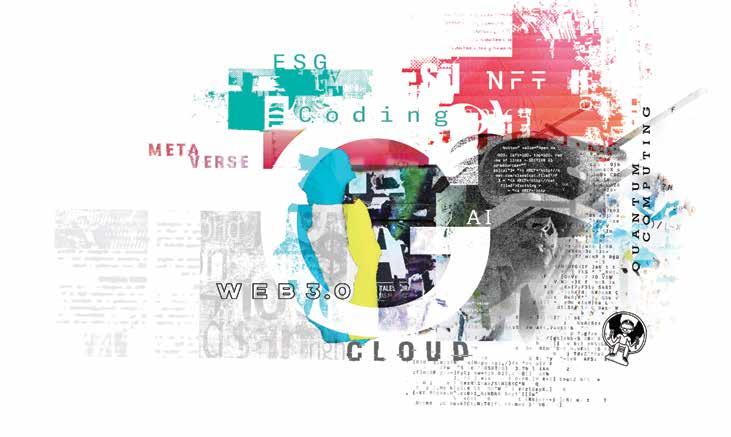The sustainability mandate

How the industrial
company
is
to cut carbon emissions of its
ISSUE 46 \ OCTOBER 2022
automation software
Kelvin
leveraging AI
clients
FVC is a Value added distributor (VAD) that provides tangible solutions across essential areas of enterprise











Unified Communications & Collaboration, Audio-Visual, Cyber



















Cloud & Artificial Intelligence and Services



SERVICES INTELLIGENCE AV
computing:
Security,






CONTENTS 18 TRUST ISSUES 22 WHAT YOU NEED TO KNOW ABOUT THE METAVERSE 25 A CURE FOR COMPLEXITY 26 THE RISE OF MACHINE LEARNING 28 CROSSING THE CHASM PUBLISHED BY INSIGHT MEDIA & PUBLISHING LLC 3018 30 AUTOMATION WITH A MISSION 36 A GITEX GLOBAL 2022 PREVIEW 49 BACKING UP YOUR DATA 50 THE UNTAPPED POTENTIAL OF AI 54 MAKING THE CHANGE 56 PRODUCTS14 HOW THE INDUSTRIAL AUTOMATION SOFTWARE COMPANY KELVIN IS LEVERAGING AI TO CUT CARBON EMISSIONS OF ITS CLIENTS THE SUSTAINABILITY MANDATE 6 NEWS RADWARE LAUNCHES NEW CLOUD SECURITY CENTER IN THE UAE VENOM FOUNDATION TO BUILD AN INFINITELY SCALABLE BLOCKCHAIN PLATFORM TRELLIX EXPANDS XDR PLATFORM TO TRANSFORM SECURITY OPERATIONS 3CXO INSIGHT MEOCTOBER 2022

































































































































































































































































































































































































































































GOOD TIDINGS
Billed as the biggest tech event in the world, GITEX GLOBAL is back with some staggering numbers. This year’s show will open doors to more than 5000 exhibitors over two million square feet of space and attract 100,000 visitors. True to its tagline of ‘enter the next digital universe’, the event will showcase some developing technologies such as Metaverse, Web 3.0, and 6G. Interestingly enough, the organisers claim GITEX will be an ideal platform to attract new companies and set up shop in the region, as 40 percent of exhibitors this year do not have a base here. Another first this year would be the largest developer meetup of 10,000 coders and the Middle East’s python-centered conference launch.
Personally, this is going to be my 17th year at the show, and it has always amazed me how this event has gone from strength to strength over the years. While tech shows of this scale worldwide have either declined or died out,
GITEX continues to flourish, setting new milestones every year. This is a testimonial to the region’s thriving IT ecosystem and governments’ ambitious strategies to transform societies and drive a sustainable future with digital innovation. 2022 will be remembered as the year the world came back to normal after the pandemic, and digital transformation has shifted from the realm of a buzzword to reality for many organisations. If you are looking to find some insights to succeed in this digital age, mark your calendar now for GITEX GLOBAL 2022 because IT leaders and companies from all over the world will be discussing what matters today for businesses.
The CXO Insight ME team will be on the ground, reporting all the major highlights and providing a first-hand view of the event. Also, in this issue, we have featured what some of the flagship tech vendors are exhibiting at the event.
and say hello to us if you are at the show.

EDITORIAL
Come
Published by Publication licensed by Sharjah Media City @Copyright 2022 Insight Media and Publishing Managing Editor Jeevan Thankappan jeevant@insightmediame.com +97156 - 4156425 Sales Director Merle Carrasco merlec@insightmediame.com +97155 - 1181730 Operations Director Rajeesh Nair rajeeshm@insightmediame.com +97155 - 9383094 While the publisher has made all efforts to ensure the accuracy of information in this magazine, they will not be held responsible for any errors Production Head James Tharian jamest@insightmediame.com +97156 - 4945966 Administration Manager Fahida Afaf Bangod fahidaa@insightmediame.com +97156 - 5741456 Designer Anup Sathyan 5CXO INSIGHT MEOCTOBER 2022
LAUNCHES NEW CLOUD SECURITY CENTER IN THE UAE
Radware has launched a new cloud security center in the United Arab Emirates.

Located in Dubai, the facility will reduce latency for in-region traffic and offer customers faster mitigation response times against denial-ofservice attacks, web application attacks, malicious bot traffic, and attacks on APIs. It will also mitigate compliance processes involved in offshore routing.
The Dubai addition complements Radware’s existing cloud security network. Today, the network includes over 10Tbps of mitigation capacity across more than 50 security centers located around the globe.
“As part of our strategic cloud services initiative, we continue to accelerate cloud innovation to provide
CLOUDFLARE LAUNCHES TURNSTILE
our customers with the highest level of cyber security services,” said Haim Zelikovsky, vice president of cloud security services for Radware. “This includes increasing the fighting capacity of our cloud infrastructure to help our customers manage the
increasing complexity and sheer volume of cyberattacks with as little disruption as possible.”
According to Radware’s First Half 2022 Global Threat Analysis Report, the first six months of 2022 saw a dramatic increase in cyberattacks across the globe. The number of DDoS attacks climbed 203% and malicious web application transactions grew by 38% compared to the same period last year.
“The new site in Dubai fills a growing demand for a local security presence that can deliver rapid response times with accuracy for organizations in the public and private sector,” said Nikhil Karan Taneja, Radware’s vice president and managing director for India, the Middle East, and South Asia. “The launch of the center underscores our ongoing commitment to delivering state-of-the-art cyber protection and scaling our capacity in a way that will benefit the whole region.”
Cloudflare announced Turnstile, a simple, private way to replace CAPTCHA (Completely Automated Public Turing test to tell Computers and Humans Apart) and help validate humanity across the Internet. Now any site owner can replace CAPTCHAs through a simple API, whether they’re a Cloudflare customer or not.
CAPTCHA has long been regarded as a terrible user experience that sacrifices privacy by harvesting user data. They
typically come in the form of a challenge that is meant to be difficult for a computer to pass but simple for a human, such as identifying stretched letters or numbers, or things like crosswalks or stop signs. It is estimated that collectively, humans waste 500 years a day trying to solve CAPTCHAs. In addition to being the speed bump of the Internet, the tests have been critiqued for their lack of accessibility, assuming all Internet users have the physical and cognitive capabilities to solve them. Privacy is also at risk; for example, Google’s reCAPTCHA, which dominates the market, may ask for users to log in to their Google account as a form of verification. No one should have to give up private information when simply trying to prove they are not a robot. Cloudflare’s solution is a drop-in replacement for reCAPTCHA that preserves the user’s privacy.
“Cloudflare is taking one of the most hated pieces of Internet technology, and making it easier, more secure, and more private for everyone to use,” said Matthew Prince, co-founder and CEO of Cloudflare. “Similar to our 1.1.1.1 app that makes every user and the Internet safer, we’re excited to

share Turnstile with developers of any size and anywhere, for an improved and more private end user experience.”
Turnstile is a smarter, invisible CAPTCHA alternative. The solution automatically chooses from a rotating suite of browser challenges that work behind the scenes, looking for signals there is a human user. Turnstile can fine-tune the difficulty of the challenge, presenting harder challenges to visitors that exhibit non-human behaviours. Additionally, Turnstile recognises Private Access Tokens from users on the latest versions of macOS or iOS, allowing Turnstile to validate a device with the help of the device vendor, and without collecting, touching or storing user device data.
Turnstile now has the same stable solve rate as previously used CAPTCHAs. With this technology, Cloudflare reduced their own use of CAPTCHA by 91% and reduced the visitor time spent in a challenge from an average of 32 seconds to an average of just one second to run the non-interactive challenges.
Turnstile is now available for any developer to use on their site, regardless of if they are a Cloudflare customer.
NEWS RADWARE
6 CXO INSIGHT ME OCTOBER 2022
FOUNDATION TO BUILD AN INFINITELY SCALABLE BLOCKCHAIN PLATFORM
Venom Foundation has been registered as the first crypto foundation in the ADGM, with a license to operate a blockchain and issue utility tokens. ADGM is well known as a fintech oasis for investors and financial services firms in the region and from around the globe. The next essential step of Venom Blockchain - its launch - will be announced soon.
Venom blockchain is an asynchronous blockchain technology of dynamical sharding, that has made an unprecedented leap in blockchain technology development globally, bringing to the market boundless scalability, and higher security guarantees with decentralisation. Venom Foundation is a leader within three core directions, such as Essential Infrastructure, Support of Inbound Projects, and Developer-friendly Platform, each to offer novel solutions for solving earlier existing issues in the crypto market. Though, the most valuable feature for the MENA region market is the technology that enables major corporations and companies to conduct an easy and
secure transition into Web3 globalisation, managing the gross data transaction flows without faltering by increasing fees and transaction times.
Venom Foundation’s main priority is to develop and support a self-sufficient blockchain ecosystem and it has already yielded significant results: non-custodial Wallet (VenomWallet mobile application and Desktop Browser Extension) with a Multisig accounts option and Ledger support, VenomScan (to keep everything transparent with access to transactions history), VenomBridge (allowing the interchain transactions to be made fast, while low price), VenomPools (to stake on Validator nodes), VenomGet (an easy gateway to Venom tokens), Web3.World (native decentralised exchange) has been built. Individual developers, companies, and government authorities will be able to engage Venom Foundation to establish new products such as NFT marketplace, Derivative Exchange, fiat-backed stablecoin, and many others to come with the potential to become a bridge toward wide adoption of CBDC in the UAE, other
TRELLIX EXPANDS XDR PLATFORM TO TRANSFORM SECURITY OPERATIONS
information and event management (SIEM) technology has failed to modernise security operations. We are confident Trellix XDR fills this critical gap.”
MENA countries and Globally. Subject to the relevant regulatory approvals, Venom Foundation will work with ecosystem participants to ensure that such products are offered in a compliant manner within the trusted and wellregulated environment of ADGM.
The Venom blockchain is an exciting project for pioneers and early-adopters and has been developed and supported by great market specialists and industry leaders who have been involved in its development and potential launch. Mustafa Kheriba, Dr. Kai-Uwe Steck are Foundation members and have given the project’s team full support and their unique and unparalleled expertise guidance.
and improve mean time to response.
Trellix has announced the expansion of its XDR platform. Trellix XDR enables the company’s 40,000+ customers to build greater cyber resiliency, maximise the value of their existing security tools, and reduce mean time to detection and response.
“We have the most comprehensive XDR platform in the industry,” said Bryan Palma, CEO, Trellix. “Legacy security

Arriving in the fourth quarter of 2022, the upgraded XDR engine provides security operations teams with enhanced playbooks for guided investigations, upgraded threat intelligence through the integration of McAfee and FireEye assets, and the launch of Trellix Event Fabric. Trellix Event Fabric bridges disparate security data from any cloud provider allowing security analysts to access and correlate data from anywhere. This combination of machine learning and automation allows security operations teams to reduce mean time detection
XConsole simplifies the user experience across Trellix XDR providing a single interface for security operations teams. Delivering a common operating picture allows customers to maximise their investments in native Trellix technologies and third-party security tools. By leveraging a single user interface, analysts and responders can quickly baseline their overall threat posture through added visibility across network, endpoint, data, email, and cloud attack surfaces. Available early in 2023, XConsole becomes the control center for Trellix XDR.
“Trellix XDR, now incorporating a unified security operations console, brings it all together by ingesting data from all technologies in an organisation,” said Dr. Ali Baghdadi, Senior Vice President & Chief Country Executive, Ingram Micro. “This easy-to-use platform is very attractive to our customers.”

VENOM
7CXO INSIGHT MEOCTOBER 2022
HELP AG LAUNCHES CYBERSECURITY OPERATIONS CENTRE IN RIYADH
integrated products, this also translates into increased efficiency and optimised performance, as well as reduced cost of operations for stakeholders. Featuring managed controls, 24/7 cyber defence, and a hybrid design to ensure customer data doesn’t leave the country or the organisational premises, our Saudi clients now also have full access to Help AG’s patented solutions in Managed Security Services.”
In addition, Fahad Al-Suhaimi, Country Director for Saudi Arabia, Help AG, said: “The launch of the Riyadh CSOC is a key milestone in Help AG’s journey in Saudi Arabia which began in 2017, and reflects our dedication to providing our customers in this market with comprehensive cybersecurity services while emphasising our continued support for Saudisation efforts in the IT sector with a team of talented nationals.
Help AG has launched a stateof-the-art Cybersecurity Operations Centre (CSOC) in Riyadh, Saudi Arabia, to provide 24/7 security monitoring and events management, along with a complete suite of locally delivered Managed Security Services (MSS), fully compliant with the local data regulations.
The CSOC in Riyadh builds on Help AG’s expertise of more than 25 years in providing world-class cyber defence to organisations in the region. The launch comes at a critical time as Saudi Arabia is accelerating its digital transformation and focusing on creating a collaborative ecosystem with the ultimate goal of becoming a global investment powerhouse – a key pillar in the Kingdom’s 2030 Vision.
As a result of this push toward digitalisation, it is now vital to build cyber resilience into every project and system from day zero and beyond. Indeed, according to an IDC survey, 54% of Saudi CIOs have embedded cybersecurity into the planning, initiation, and assessment phases of all new business initiatives. The survey also found that the top cybersecurity strategy goals in Saudi Arabia are related to Managed Security Services, with key focus areas in 2022 being
managed Security Information and Event Management (SIEM), Managed Detection and Response (MDR), and threat intelligence.
Commenting on the launch, Stephan Berner, Chief Executive Officer at Help AG, said: “With increased digital adoption across Saudi Arabia, embedding cybersecurity in every project and process has quickly emerged as a top-ofmind moving target for organisations in the kingdom. The launch of our stateof-the-art CSOC reflects Help AG’s deep commitment to supporting Saudi Arabia’s vision of digital transformation. Featuring our next-generation security operations framework for enterprises and governmental entities, as well as offering flexible deployment through cloud, onpremise or a hybrid model, the CSOC in Riyadh will enable our Saudi clients to take timely action on the basis of threat intelligence feeds and through our security orchestration and automation platforms.”
Safwan Akram, MSS Director at Help AG, who leads the MSS team at the Riyadh CSOC, said on the occasion: “Our new CSOC in Saudi Arabia brings enhanced visibility and early detection of cybersecurity incidents for our clients in the country. With a reduced attacker dwell time and streamlined

“The launch comes as more organisations recognise the vital importance of Managed Security Services for establishing cyber resilience in the modern threat landscape. In fact, we forecast that 90% of all cybersecurity requirements will be fulfilled by a service model in three years, reflecting an industrywide shift which we are spearheading in the region through delivering global and advanced security services while moulding them to address regional market threats and requirements.”
The CSOC houses security analysts who monitor complex IT security infrastructures as well as analyse and interpret critical security events or abnormal behaviour. In addition to Managed Detection and Response (MDR), Help AG offers a wide range of services, including Digital Forensics and Incident Response (DFIR), threat hunting, Managed Security Controls, network and user behaviour anomaly detection, vulnerability assessment, and red teaming, while leveraging in-house curated advanced threat intelligence.
The CSOC also integrates Help AG’s other distinguished services such as its Security Service Edge (SSE) offering –Cyber Edge X, and Managed Digital Risk Protection (DRP).

NEWS
8 CXO INSIGHT ME OCTOBER 2022
The For tinet Security Fabric
Broad visibility and protection of the entire digital attack surface to better manage risk
Integrated solution that reduces management complexity and shares threat intelligence
Automated self-healing networks with AI-driven security for fast and efficient operations
Cloud Security Open Ecosystem FortiGuard Labs Threat Intelligence Secure Networking Network Operations Security Operations Zero Trust Access
Meet us at GITEX, Hall 7, Booth A20

NVIDIA STUDIO AT TWOFOUR54 YAS CREATIVE HUB CAMPUS
NVIDIA announced the launch of an NVIDIA Studio at twofour54’s Community Hub in Yas Island, Abu Dhabi, to support aspiring artists and industry professionals who are thriving in the content-focused Yas Creative Hub campus.


The NVIDIA Studio comprises 10 state-of-the-art Studio computers equipped with the latest GeForce RTX Studio GPUs, alongside NVIDIA RTX accelerated applications. This means regional content creators will benefit from smoother, faster, and more efficient workflows and see their ambitious projects come to life.
NVIDIA is also inviting regional content creators to participate in its global NVDIA Studio program and submit their content; the best of which will be officially recognised and highlighted on NVIDIA’s website, blogs, and social media

channels. All they need to do is reach out to NVIDIA Middle East and submit their content to NVIDIA’s @ NVIDIAGeforceME twitter channel.
Commenting on the new NVIDIA Studio at Yas Creative Hub, Chantelle Tavid, Head of Marketing at NVIDIA, said: “We are thrilled to launch our new NVIDIA Studio at twofour54’s a new Yas Community Hub. The campus is the ideal location for Abu Dhabi’s creative professionals to collaborate and develop rich content. As enablers of next generation digital content, we are keen to be part of this vibrant ecosystem.”
“NVIDIA Studio desktops and laptops are the ultimate platform for content creators wishing to express uninhibited creativity. With their AI-enabled GeForce RTX graphics cards, these laptops and PCs are designed specifically to accelerate creative applications and offer
superior performance even when multiple applications or resourceintensive files are being worked on.
Thanks to AI technology, NVIDIA Studio laptops and PCs have proven to be over five times faster than standard desktops and laptops when working on 3D, motion graphics, photo, and video editing workflow. This makes them the best possible choice for creators.”
The NVIDA Studio at Yas Creative Hub will be equipped with four NVIDIA Studio Laptops powered by GeForce RTX 3080 Ti GPUs (Razer), and three NVIDIA Studio Laptops powered by GeForce RTX 3070 Ti GPUs (ASUS ProArt), in addition to three NVIDIA Studio desktop PCs boasting GeForce RTX 3090 Ti GPUs. The industry leading GeForce RTX GPUs also feature dedicated hardware to accelerate key operations like Ray Tracing, Simulations, and AI.
NVIDIA LAUNCHES
NEWS 11CXO INSIGHT MEOCTOBER 2022
GLOBAL 2022 TO TRANSFORM DUBAI INTO WORLD’S DIGITAL EPICENTRE
Dubai will transform into the ultimate digital epicentre of the world next month, as the UAE hosts the world’s largest tech show, converging the most advanced companies and best minds to deep dive into the making of the Web 3.0 economy.
From 10-14 October 2022 at the Dubai World Trade Centre, GITEX GLOBAL returns, its largest ever edition featuring 5,000 companies spanning 26 halls and two million sq. ft of exhibition space, at an extraordinary 25 percent year-onyear increase, pushing its capacity limit at the venue.

The GITEX 3.0 edition, in its 42nd year presents the most empowering curation ever with seven multi-tech themes experimenting in the metaverse, a decentralised future of the internet, and a sustainable global digital economy.
The five-day event’s record size and continued expansion mirrors the ambitions of the UAE and region’s digital transformation movement, as government initiatives such as the National Program for Coders, the Dubai Metaverse Strategy, and Next GenFDI
propels the UAE to the forefront of the global digital economy.
This is amplified by new GITEX GLOBAL 2022 launches of X-VERSE sponsored by TMRW Foundation in collaboration with Decentraland, one of the world’s most immersive metaverse journeys featuring 28 experiential brands and Global DevSlam, the Middle East’s largest ever coder and developer meetup, both of which sold-out to a global audience within two months.
UAE companies also held the lion’s share of a record-breaking US$2.6 billion in start-up funding across the Middle East and North Africa in 2021, figures that underscore an additional hall and 30 percent increase to 1,000 exhibitors at GITEX GLOBAL’s start-up event, North Star.
His Excellency Omar Al Olama, Minister of State for AI, Digital Economy & Remote Work Applications, who delivered the welcome note at the official GITEX GLOBAL 2022 press conference today, said: “GITEX this year is bigger than ever. It spans two million sq. ft. with over 5,000 exhibitors
from more than 90 countries, which makes this truly the biggest tech show in the world. This year, my office has partnered with GITEX to ensure that we’re not just showcasing technology, but actually inventing and developing technology.”
In his speech H.E. also highlighted that the Global DevSlam event is poised to be one of the biggest developer events in the world. He concluded by thanking each and every single person that has believed in the UAE’s mission and who has supported the UAE.
Trixie LohMirmand, Executive Vice President of Events Management at Dubai World Trade Centre, GITEX GLOBAL’s organiser, added: “GITEX is not just a big gathering of people. It’s the super-connector humanising the virtual and digital economies.
“GITEX serves a profound purpose of enabling and accelerating the digital economies of UAE and many of its alliance partners through connecting earnest stakeholders with outstanding minds from the world and materialising these connections into actionable partnerships.”
NEWS GITEX
12 CXO INSIGHT ME OCTOBER 2022
Step 4Step 1 Step 2 Step 3











A Professional Omada SDN Controller Existing in the Cloud Cloud-Based Controller Exists Entirely in the Cloud Unlimited Centralized Management Scale No Additional Hardware Controller Investment No Installation on Customer Premises Cloud with Higher Efciency—Zero-Touch Provisioning Centralized Management for Access Points, Switches, and Routers 1 G et a n accou nt 2 Log in 3 B ind t he dev ices O m ad a Acces s Point Jet S t rea m S w i tchOmada Router O m ad a M a n age me nt I nte r f ace O m ad a A pp We b B row se r Cloud Internet Cloud B ased Cont roller Cloud Devices automatically obtain the confguration fle from the cloud Enjoy 100% remote provisioning and cloud management
Plug in on-site and connect the Omada Powered devices to the internet Enroll the devices through your Omada Cloud Dashboard
LEADING THE FIGHT AGAINST CARBON EMISSIONS
PETER HARDING, FOUNDER AND CHIEF EXECUTIVE OFFICER OF KELVIN, DISCUSSES HOW THE INDUSTRIAL AUTOMATION SOFTWARE COMPANY IS HELPING BUSINESSES IN THE MIDDLE EAST ACHIEVE THEIR NETZERO GOALS AND FAST-TRACK DIGITAL TRANSFORMATION.

What kind of opportunities do you see for Kelvin in the Middle East market?
We see significant opportunities in the energy sector, primarily in production enhancement, sustainability initiatives for the upstream and midstream areas of oil and gas. We are also helping industrial organisations looking for ways to improve the efficiency of their operations. Kelvin can empower their engineers and experts to achieve sustainability and profitability goals.
We are focused on the energy sector today. There are many opportunities with customers amongst National Oil Companies and large multinationals with a presence in the Middle East. We have previously worked with customers in the Middle East and believe there are opportunities to continue Kelvin’s expansion in this market.
What can businesses in the Middle East do to become more sustainable and reduce carbon emissions? It starts with maximising efficiency of
existing operations. We work with your existing infrastructure to improve it to its absolute best, and then take that knowledge and extend it as you move into new areas of development.
We look for situations where there may be leaks, breakages, and other challenges with the physical infrastructure that can be addressed. We believe that if you find those problems quickly, you can fix them rapidly, and that’s where the journey begins.
We have developed our software to seamlessly find inefficiencies, diagnose them, and then act on them. We’ve been able to show a very real connection between the inefficiencies that may exist in an individual part, a component of an asset, or a system and what that means in terms of additional energy costs and carbon impact. When you go and fix that problem, you get the benefit both from a cost savings point of view and, more importantly, the opportunity to address net-zero objectives. Kelvin is helping to achieve sustainability goals and increase the speed to realising this value.
COVER STORY
14 CXO INSIGHT ME OCTOBER 2022

CXO INSIGHT ME 15OCTOBER 2022
How new is this technology and this concept, globally and in the Middle East region?
The approach that we’ve taken with our software is new. Historically, there have been a series of manual processes by people doing basic analysis to find inefficiencies. We take a different approach. Kelvin’s Collaborative Control software company delivers industrial intelligence through a combination of human understanding and artificial intelligence. We’re focused on bringing knowledge and transferring it into the software so that smart decisions scale easily across the organisation. We’ve been actively working in the US and Australia for the last five years. We’re beginning to open up opportunities in the Middle East for this technology to be utilised.
Could you tell me a bit about the technology behind Kelvin? Are you leveraging AI and IoT analytics?
We’ve developed a software layer that connects to the existing physical infrastructure at the customers’ fields and operations. We’re building a bridge between those current capabilities and the future by codifying human knowledge into software. We use Artificial Intelligence in the context of pattern matching. When you have someone in engineering working on a particular problem, they’re looking for aberrations, anomalies, and changes in patterns in those systems. What’s terrific about new software tools is that they can also look for those patterns across other data types once they are identified. It is all about blending human understanding and AI, which allows you to create something unique and powerful across the whole operation.
And does that also incorporate Machine Learning?
Yes. There is a learning aspect of this, where once you’ve seen a pattern, Kelvin can look for it across other
datasets and take action. Automated systems have been told what to do and are trained to do something a certain way. As you move to autonomous systems, where you have systems that are beginning to learn, there’s an element of discovery and exploration that can exist. This is the real future that we are rapidly approaching. We have customers on that journey today, who are already moving into this autonomous phase. They can start by explaining what they want Kelvin to do and have it follow those rules to create a base-level understanding and infrastructure for the system. Once that is established, then Kelvin can explore new areas of optimisation in the future.
Could you tell me what you think a CIO’s role is in a company’s ESG strategy?
I believe the CIO is there to help enable the necessary infrastructure, which
can help achieve the ESG goals of the organisation. In that context, the first step is gathering the information and discovering how a physical system performs. I see that as organising the data coming in from sensors, images, or otherwise and unifying that with existing data streams coming out of control centers. You have to ensure that that data is consistent, available, contextualised, and in an actionable format. That’s the next piece. The CIO is helping to enable three phases - unifying the data into information, analyzing this information, and empowering the actions.
How can digital twins help organisations to reduce their emissions?
A digital twin should be a virtual representation of a physical system, coming from two dimensions –understanding an asset and its process. For example, in the energy sector, everything will probably have an asset as part of a broader process. So it is incumbent upon the digital twin to be as accurate as possible in representing that asset and the process. When you do that successfully, you’re in a position to run things securely and seamlessly like different types of alert mechanisms, simulations, and other items in the future.
What direction will your commitment to sustainability take next?
Our focus right now is solving realworld problems. There’s much momentum in the market around what’s possible from a sustainability point of view. It is incumbent upon us to deliver on the promise and show real impact by reducing carbon emissions. We are looking for customers and partners committed to making these changes and measuring those results. Kelvin helps demonstrate how operational improvements impact sustainability goals.
OUR FOCUS RIGHT NOW IS SOLVING REAL-WORLD PROBLEMS. THERE’S MUCH MOMENTUM IN THE MARKET AROUND WHAT’S POSSIBLE FROM A SUSTAINABILITY POINT OF VIEW. IT IS INCUMBENT UPON US TO DELIVER ON THE PROMISE AND SHOW REAL IMPACT BY REDUCING CARBON EMISSIONS.
COVER STORY 16 CXO INSIGHT ME OCTOBER 2022
Transform your future
Today’s fast-changing world demands smarter operations and a more resilient supply chain. Infor cloud solutions, with built-in industry-specifc functionality, provide manufacturers and distributors with the data insights they need to not only remain competitive—but thrive.
Be future-ready.
Visit the Infor booth H7-E50 at GITEX Global, the largest technology show in the Middle East and Africa.




Copyright ©2022 Infor. www.infor.com. All rights reserved.
infor.com/mea
and even the critical services of organisations, he says.
Frank Kim, SANS Fellow and Information Security Consultant, says with the increased use of cloud services and modern architectures relying on APIs and microservices, the computing landscape has changed. The older perimeter-based model is untenable for these modern architectures. Zero Trust helps CISOs and security leaders incorporate other important “perimeters” such as identity, application, and data protections that take these new paradigms into account.
Ashraf Sheet, Vice President – META, Swimlane, agrees: “An increase in cloud-based environments and more


TRUST ISSUES
READY TO JUMP ON THE ZERO TRUST BANDWAGON? INDUSTRY EXPERTS EXPLAIN THE STEPS THAT WILL KEEP YOUR STRATEGY ON TRACK.
The hype around the Zero Trust model has reached a crescendo. It is being touted as the new necessary way of life for businesses as they transition from perimeter-based security to this new security methodology based on leastprivileged access.

For organisations looking to adopt a Zero Trust security model, it is important to understand some common myths and misconceptions. First of all, Zero Trust is not a product, and it doesn’t address any technology problems. No one call sell you a Zero Trust solution. Instead, it is all about a new security mindset that is centered around the idea that enterprises should not automatically trust anything without verifying users, devices, and networks.
What is driving the growing appetite for Zero Trust architecture?
“With the continued growth of the bring your own device (BYOD) and work-fromanywhere (WFA) phenomena, more and more employees need to have access to their organisation’s internal resources from any place at any time. It is worth highlighting that the pandemic saw a gigantic increase in brute-force attack attempts against the remote desktop protocol (RDP), demonstrating the high interest of cybercriminals in taking advantage of the current remote work situation,” says Alain Penel, Regional Vice President – Middle East & Turkey, Fortinet.
Another component driving Zero Trust is the growing adoption and use of storage services in the cloud. The cloud often hosts the data, resources,
FEATURE
Ashraf
Sheet
Alain Penel
18 CXO INSIGHT ME OCTOBER 2022
remote workers logging in from anywhere have transformed traditional security strategies. Because the corporate network and data are accessible from any location, new vulnerabilities become exposed. Rather than assuming that internal users of a network are safe, modern security frameworks need to accommodate these new risks. Zero Trust is the best way to counter these new challenges.”
Zero Trust has grown in popularity recently among technical and nontechnical audiences, says Bachir Moussa, Regional Director – MEAR, Nozomi Networks.“It’s simple to grasp the factors contributing to this success: the trustby-design methodology is out-of-date and has demonstrated how disastrous outcomes can occur when a device or application is trusted a priori without taking context into account. With data and applications operated on remote cloud services and an increase in the usage of mobile and IoT devices, the security perimeter strategy is no longer as effective today,” he adds.
Key principles of Zero Trust
With so many definitions of zero Trust around, security leaders must cut through the noise and understand the basic tenets.
Trust nothing. Ever, says Harish Chib, vice president Middle East & Africa, Sophos. “For when you trust nothing, you are forced to seek relevant security

measures wherever there is a risk. Verify everything. Do not assume that passing a check naturally affords Trust. Having credentials doesn’t mean you are trustable. It just means you have credentials. And credentials can be stolen,” he warns.
Sajith Kumar, General Manager –Enterprise at Cloud Box Technologies, says for successful implementation of zero trust security - Identify, Protect, Detect and Respond is key. Organisations must expand their focus from protecting the network perimeter to individual systems and services. Conventional perimeter-based security strategies require one to identify and protect all potential vulnerabilities around network devices with policies that control the account for every possible flaws.
As your surface of network perimeters grows with public cloud, hybrid work force, remote users, data centers and other complications, the possible attack surface also grows more complexities, he says.

Penel from Fortinet says with zero Trust, no devices are allowed to connect to corporate resources freely. Instead, any user or device requesting access must provide validated credentials. Even then, they are only permitted to access the minimally required resources needed to do their job.

“By denying all unvalidated traffic by default, bad actors and compromised devices can’t even ping the network to explore its resources, let alone the rest of
the network. Organisations must adopt two critical strategies to implement a true zero trust approach to cybersecurity: zero trust access (ZTA) and zero trust network access (ZTNA),” he says.
Can enterprises leverage their existing security infrastructure to transition to zero trust security?
Joseph Carson, Chief Security Scientist & Advisory CISO, Delinea, says organisations implementing the Zero Trust security model quickly find that it’s the opposite of how they have traditionally approached network security. Switching from trusting everything to trusting nothing—and always verifying— could increase friction for employees and have a negative impact on productivity if appropriate measures are not taken.
He adds it’s imperative to have a holistic approach to security, ensuring that all systems are integrated, flexibly respond to different threats, and provide high levels of automation for minimal friction. A successful Zero Trust security model means prioritising zero friction security. When you implement security controls, they must be better than the previous experience.
According to Kim from SANS, since Zero Trust is not a product but an approach and architecture that allows us to realise key principles, you can definitely use existing security infrastructure to enable Zero Trust capabilities. Existing
Harish Chib Joseph Carson
Frank Kim
19CXO INSIGHT MEOCTOBER 2022
approaches like client-side certificates and TLS can be used to ensure all traffic is encrypted.
“Existing tools can be used to maintain visibility. Of course, using cloud services and cloud-first solutions can make this easier, but Zero Trust can be applied to existing environments as well,” he says.

Sheet from Swimlane says there are some best practices to keep in mind as part of a transition to Zero Trust security. First, security teams should begin the transition by assessing the specific risks that threaten the organisations and considering the data stored and transmitted across the network.
After assessing the specific risks, teams should consider implementing microsegmentation. This protects against internal threats and is a central step on the road to implementing least-privilege access across the organisation. Finally, with micro-segmentation and encryption in mind, consistent and repeated verification is one of the most important practices in a Zero Trust framework.
“Whenever a user wants to access a new part of the network or some new information, a verification process must be established. Overall, it is important to remember to continuously collect and analyze data from the network and security environment to validate and quantify its efficacy. A low-code security automation platform can play an instrumental role, serving as a system of record for all security operations,” he sums up.
THE EXPERTS SPEAK
THE MOST BASIC EXPLANATION OF ZERO TRUST IS IN THE NAME: TRUST NOTHING. AUTHENTICATE, AUTHORIZE, AND CONTINUOUSLY VALIDATE ALL USERS, DEVICES, AND OTHER RESOURCES. WITH THE NOTION OF ZERO TRUST, FOR EXAMPLE, WE NO LONGER LOOK AT A “TRUSTED” INTERNAL NETWORK VERSUS AN “UNTRUSTED” EXTERNAL NETWORK, NOR DO WE THINK OF THE NETWORK PERIMETER AS THE “EDGE” FOR SECURITY. INSTEAD, TODAY THE EDGE IS THE ACCESS POINT SOMEONE IS USING TO TRY TO REACH RESOURCES.
ZERO TRUST ASSUMES THE NETWORK HAS BEEN COMPROMISED AND CHALLENGES THE USER OR DEVICE TO PROVE THAT THEY HAVE AN ACCEPTABLE RISK LEVEL. IT REQUIRES STRICT IDENTITY VERIFICATION FOR EVERY USER AND DEVICE ATTEMPTING TO ACCESS RESOURCES ON A NETWORK, EVEN IF THE USER OR DEVICE IS ALREADY WITHIN THE NETWORK PERIMETER.
“ZERO TRUST ALSO PROVIDES THE ABILITY TO LIMIT ACCESS ONCE ANYONE IS INSIDE THE NETWORK, PREVENTING AN ATTACKER FROM EXPLOITING LATERAL FREEDOM THROUGHOUT AN ORGANIZATION’S INFRASTRUCTURE.
IN A ZERO TRUST ARCHITECTURE, THE AUTHORISATIONS ARE VERIFIED AT EACH ACCESS ACROSS SEGMENTS. IF THERE’S ZERO TRUST IN THE SECURITY TOKEN THAT WAS ASSEMBLED EARLIER, WE’RE GOING TO GENERATE IT AGAIN OR AT LEAST CONFIRM THE ELEMENT RELEVANT TO THE ACCESS BEING MADE ARE STILL VALID. ZERO TRUST STILL RELIES ON THE FOUNDATIONAL CONTROLS AND TECHNOLOGIES THAT MOST ORGANISATIONS STILL FAIL TO GET RIGHT, SUCH AS VULNERABILITY MANAGEMENT, PATCH MANAGEMENT, CONFIGURATION MANAGEMENT, IDENTITY AND ACCESS MANAGEMENT, ENDPOINT PRIVILEGE MANAGEMENT, SECURE REMOTE ACCESS AND PRIVILEGED PASSWORD MANAGEMENT. THERE ARE MORE, BUT THOSE ARE THE ‘POSTER CHILDREN’ AS MOST SUCCESSFUL ATTACKS BEGIN WITH A GAP IN ONE OR MORE OF THOSE.”
Brian Chappell, chief security strategist, EMEA & APAC, BeyondTrust



FEATURE
Toni El Inati - RVP Sales, META & CEE, Barracuda Networks
Bahaa Hudairi, Regional Sales Director – META, Lookout
Sajith Kumar
20 CXO INSIGHT ME OCTOBER 2022










































THE NEW LOGIC OF WORK Hybrid Work, Equitable Meetings and The New Logic of Work VIDEO MEETINGS THAT RAISE THE BAR Introducing Logitech Rally Family
WHAT YOU NEED TO KNOW ABOUT THE METAVERSE
THE METAVERSE IS IN VERY EARLY STAGES AND WILL BEGIN TO MATURE BY THE END OF THE DECADE PUTTING PRESSURE ON PRODUCT VENDORS TO INNOVATE AND CO-EXIST SIDE BY SIDE, EXPLAINS SIMRAN BAGGA, VICE PRESIDENT OF OMNIX ENGINEERING AND FOUNDATION TECHNOLOGIES

technology and service providers will build on available and emerging technologies. As the technologies move from start-up and early growth to mature growth and decline, so will their products. New businesses will arrive built on the next wave of emerging technologies, and the cycle will repeat itself.
This has always happened for every innovative and disruptive technology cycle in modern civilization, and there is no reason to believe that this will not happen with the Metaverse as well.
By the end of this decade, the Metaverse would have matured, supported by technologies and platforms that are still on the drawing board today. Unlike the Internet, which is a global network of data transfers, the Metaverse will be a digital network of virtual real-life experiences. Similar to the Internet, there will finally be only one Metaverse as there is only one global Internet.
According to Gartner, when completed at the end of the decade, no single company will own, control, or develop all the technology to build its own Metaverse or the Metaverse as a whole.
The impact of the Metaverse is expected to be so disruptive that Gartner expects 25% of people to spend at least one hour a day inside the Metaverse by 2026.
Today, the Metaverse is an immersive virtual world made possible by the early use of virtual reality and augmented reality headsets and devices. It functions as a network of 3D virtual worlds brought together by some form of social connections.
Dependence on augmented and virtual reality and immersive experiences are key aspects of the Metaverse. This requires a high level of graphics capability and portability of the headsets. Innovation is underway in this area, namely around lightweight wireless headsets, with retina display pixel density, at affordable costs.
The Metaverse will not mature before 2030 according to Gartner. However, its impact, similar to the Internet is so highly disruptive in the way humans and businesses interact that nobody
should wait till 2030 before transforming themselves or their business.
There are at least three areas to consider and evaluate:
1. The first is how entities inside the Metaverse would engage with one another or how they would interact.
2. The second is how dynamic content will be displayed in real life inside the Metaverse, at a certain point of time, at a certain location, and to a defined set of people.
3. The third is the type of scalable infrastructure required to support a mature Metaverse, and this type of technology platform does not fully exist today.
It is for this reason that future service providers and technology product developers who plan to be significant players by the time Metaverse is mature, have no option but to plan, build, and scale, in parallel and without delay.
Similar to the arrival of PCs and the Internet in the last two decades,
Technology vendors building new products for the Metaverse need to monitor opportunities for innovation and disruption along the following lines:
• Build a continuous pipeline of innovative products to carry through the multiple cycles of technology
• Leverage the combination or convergence of emerging technologies in these products
• Avoid getting carried away with the idea of a killer application being a silver bullet to generate a torrent of growth
• Identify how products can support high-value use cases like wayfinding and navigation applications meant for augmented reality
• Start developing an ecosystem of partners to build on your standards of content and services
Also identify and support leading use cases such as:
• Higher education and specialized areas such as medicine, military
• Virtual events such as webinars and product launches
• Providing retailers and e-tailers with immersive shopping
• Augmented workspaces for employees especially those working remotely or in hybrid
• Engaging with social media in the Metaverse, will allow users to create their three-dimensional avatars
Since the Metaverse is in the early stages of development, technology vendors need to be aware of the risks while investing in innovation and product development to support emerging business models in the Metaverse.
VIEWPOINT 22 CXO INSIGHT ME OCTOBER 2022






Simple. Powerful. Secure IT. Come visit us at GITEX! October 10 – 14 | Dubai | H7-F30 » Over 300,000 customers in 190 countries from SMB to Fortune 500® » 499 of the Fortune 500 are customers » #1 in Network Management * » 50+ IT management products solarwinds.com * IDC Worldwide Network Management Software Tracker 2H 2020.
A CURE FOR COMPLEXITY
THE LATEST SOLARWINDS IT TRENDS REPORT REVEALS AN ALARMING RISE IN IT COMPLEXITY. SASCHA GIESE, HEAD GEEK AT SOLARWINDS, TALKS ABOUT NEW REALITIES OF HYBRID IT AND HOW OBSERVABILITY CAN HELP.

Can you share with us key findings from this year’s report?
We do this survey every year, and this year, we wanted to understand our customers’ pain points. And it is simple – IT complexity. The level of complexity might vary depending on the organisation, but it is still the biggest problem they are currently facing. The reasons for this are manifold. If an organisation wants to gain a competitive advantage and offer new services, they usually put in place some new technologies that would bring benefits to the business. The problem is that every new technology needs people who understand and can manage it. And it is not always easy, and if you look at smaller IT teams, they don’t have the time for new technologies because there is always something else they need to fix. Similarly, some organisations can’t afford to get skilled resources on board to deal with these new technologies. So rising IT complexity is the biggest problem we have discovered.
What is creating this increasing IT complexity?
It is the changing business requirements that are contributing to this. Each new product – be it software or hardware- that anyone sells, including us, we say is easier to use. But you must remember that an organisation doesn’t have one or two tools – they have 100s. So the whole construct in IT is getting more complex, and it is based on the changing requirements of the business. Everything has to be available 24/7 from everywhere. That wasn’t the case 10-15 years ago, and it will only worsen.
If you look at modern application delivery, we have decentralised applications with microservices and multiple hyperscalers, and no one understands this landscape anymore. This is complexity, and definitely, the root cause is digital transformation.
Why is it challenging to manage hybrid IT environments today?
I think one of the challenges is constant change. If something works in a particular way today, it might work differently tomorrow. You can’t really plan things anymore. When you put something in the cloud, you do it because of availability, scalability, etc. That is fine, but you have zero control over what really happens there. So it is useless if we don’t understand applications anymore, and how it impacts the whole organisation, not just the operational IT team. It also has an impact on many other things, such as security. If we don’t understand how
an application talks to another, we can’t distinguish normal operations from a threat in the background.
Is it a problem faced by large enterprises rather than small businesses?
It is more for larger enterprises because a small company probably won’t need distributed application delivery. However, they still face different problems, but the really complex construct in IT is something for the enterprise. They want the latest and greatest in technology without even considering if it is an advantage to the business; they just want it. And they get it even if they don’t need it and create this unnecessary complexity.
You are talking about the need for observability in this report. Is it because traditional monitoring tools aren’t doing the job?
Observability has become a buzzword and means different things to different people. On a basic level, it is just an evolution of monitoring. We now have access to more data from distributed applications, cloud, etc., and traditional monitoring tools, created 10-15 years ago, can’t cope with these dynamic environments. So we needed evolution, and that is observability. Previously, we were more interested in finding out if an application is available and working. Now, we want to know what my application does all the time. How is it behaving, and what is happening inside it?
This will allow us to optimise these workloads further, which is why we need observability.
Can your platform observe the entire IT stack?
We come from a network management system background and have grown significantly in these last 15 years. Our current platform is called hybrid cloud observability, and as the name suggests, we deal with onprem, private cloud, public cloud, and multicloud. So we can observe their infrastructure, applications, and networks wherever the customer is. In addition, we have specific insights into more complex applications, like databases, Active Directory, etc. And we use many different technologies so that we are no longer stuck with SNMP or WMI.
INTERVIEW 25CXO INSIGHT MEOCTOBER 2022
THE RISE OF MACHINE LEARNING
ENTERPRISES ACROSS VIRTUALLY EVERY INDUSTRY ARE ADOPTING MACHINE LEARNING SYSTEMS. HERE IS WHAT YOU CAN DO WITH ML TODAY.
Leveraging AI and machine learning to better use data and improve decision-making has become a strategic priority for enterprises in the Middle East looking to remain competitive in the post-Covid world.

Though the concept of machine learning is not new, digital businesses are adopting this disruptive technology driven by the availability of sensor data and cloud-based platforms. Gartner says ML has become so pervasive that most of us use it daily without even noticing. The research firm says whether you are searching the web or using speech recognition on a smartphone, you are most like benefiting from ML.
“With the developments being made in machine learning, the practical uses of the technology are adding up to be endless. One of the unique features of ML is that it is highly versatile, as
ML models can be deployed across a variety of industries. They are especially useful in situations where quickly analyzing numerous amounts of data to predict outcomes is key,” says Ahmed Eid, Director – Presales, META, Dell Technologies.
In the future, machine learning systems will be further enhanced to help anticipate trends and identify problems, thereby playing an important role in supporting decision-making processes across various industries.
“We can also expect the capabilities of machine learning to significantly increase due to quantum computing, where ML will acquire the capability to create systems that execute multi-state operations simultaneously, thus tackling complex issues in a split second,” says Eid.

By establishing human-machine partnerships, businesses will be
primed to improve productivity and employee and customer satisfaction. Consequently, they will be able to focus on what matters and explore new valuegeneration opportunities.
“Machine Learning (ML) is one of the most versatile and powerful technologies of our time and one that is creating huge strides. Amazon, Netflix, Facebook, and more leading companies have aspects of their businesses or the main product heavily using ML techniques,” says Talal Shaikh, Associate Professor, Director of Undergraduate Studies for the School of Mathematical and Computer Sciences, Heriot-Watt University Dubai.
Quantum Computing and Automated Machine Learning (AutoML) are among the future trends of machine learning. Quantum Computing has the potential to boost machine learning capabilities through faster data processing and performance enhancement. It can improve data analysis and develop profound insights, enabling companies
FEATURE
Ahmed Eid
26 CXO INSIGHT ME OCTOBER 2022
to get better and faster results than traditional methods. Currently, no commercially ready quantum computing is available, but with tech companies investing in this technology, we should expect its rise soon.
“Another rising trend is automated machine learning or AutoML, which can simplify complex machine learning models and techniques, allowing wider use even by individuals with little experience in developing AI models. The technology can allow data preprocessing, algorithm selection, feature engineering and more,” says Shaikh.



Almost every industry is powered by ML, including healthcare, manufacturing, and automotive. In fact, the global machine learning market is predicted to grow from $8.43 billion in 2019 to $117.19 billion by 2027.
“Overall, AI and ML can automate repetitive tasks and enable humans to deliver maximum impact in their fields of work. In healthcare, there has been an acute shortage of healthcare personnel in most geographies. ML can help fill this gap by providing insights from smart devices. For example, it can infer results from tests, such as ECGs, without requiring a medical specialist to interpret them. ML can also help develop vaccines and drugs faster than traditional techniques,” says Ramprakash Ramamoorthy, director of AI research at ManageEngine.
He adds the manufacturing industry
can use ML techniques like computer vision for better quality control of finished goods. It can also help reduce workplace hazards for the personnel on the manufacturing floor and increase efficiency, and decrease costs.
In the automotive sector, ML can help build fail-proof components, thereby reducing the cost of ownership. In addition, AI can ensure greater vehicle safety. Techniques like advanced driverassistance systems are increasingly using AI to provide safer commutes. ML can identify driver safety issues, such as those related to drowsiness, by constantly monitoring driving parameters.
Benefits of ML in the cloud Major cloud providers have built ML platforms to support the complete lifecycle – from planning to production, which can be quite resource-intensive if you do it on-prem.
“Today, most machine learning (ML) and AI workloads depend on cloud data centers’ massive computational, processing, analytics, volume storage, memory, and graphic processing capabilities. It is generally agreed that the cloud is a cost-efficient platform to host ML and deep learning (DL) workloads without investing in expensive hardware. With cloud, it is also easy to scale up, and therefore organizations just starting-out or experimenting with ML can easily test and deploy smaller projects,” says Eid from Dell.
Additionally, organizations typically turn to cloud service providers (CSP’s) for ML and AI workloads because they have a reservoir of development tools and other resources readily available such as pre-trained deep neural networks for voice, text, image, and translation processing. Moreover, for organizations without an expert staff for AI projects, these platforms build DL neural networks automatically, saving weeks or sometimes months of labor, he adds.
Sid Bhatia, Regional Vice President & General Manager, Middle East & Turkey, Dataiku, says in traditional IT contexts, the risk and cost of lock-in are critical in assessing and adopting new technologies. In the age of Enterprise AI, this phenomenon is magnified exponentially as AI/ML technologies come and go with no sign of a reduction in the pace of innovation. In addition, the shift to cloud providers continues to create interdependencies between different components of the full AI stack. This necessarily means that companies have to become more elastic, able to adapt and drop technologies as they arise.
“It also means that in order to provide an experience for end users who are interacting with data and AI systems that is unchanging despite underlying architecture, organizations need to have a layer that sits on top of existing systems. The elastic scale of the cloud is an enabler and accelerator for AI/ML adoption,” he sums up.
Ramprakash Ramamoorthy
Sid Bhatia
Talal Shaikh
27CXO INSIGHT MEOCTOBER 2022


AUTOMATION WITH A MISSION
BOB DE CAUX, VP OF AUTOMATION AT IFS, ON HOW TO IMPROVE SUSTAINABILITY OUTCOMES USING AI AND AUTOMATION IN THE ENERGY, UTILITIES AND RESOURCES SECTOR
The energy sector needs to shift from a ‘tech-first’ to an ‘outcome-first’ mindset if it is to make the pivotal connection between data and sustainability in the years to come. Automation is rightly regarded as the hero to connect the two but is currently lacking a clear mission.

The need to collate, analyse and utilise a company’s own information for improved decision-making and enhanced customer personalisation is matched by a simultaneous need
to become more efficient, more streamlined, more environmentally conscious, and more ethical.
To connect the two and become more sustainable through automated collection and analysis of data requires a shift in mindset and, inevitably, investment into technologies that can help to meet these goals. However, what too few businesses are doing at present is approaching the challenge in that exact order: mindset and culture first, before turning to those solution suites thereafter.
Solutions such as machine learning can only feed off the questions being asked of it, and the data being presented as a result.
If the initial culture isn’t geared up to ask the right questions and push towards achievable and clear goals on the sustainability front, then the tech won’t be able to flex its muscles.
For many, it might be time to take one step back and reassess the original sustainability mission.
VIEWPOINT
30 CXO INSIGHT ME OCTOBER 2022

False starts
A familiar trend across all industries, and indeed in the energy domain, has seen businesses in such a rush to collect more data, that they’ve not put in place a structure that points this data in suitable, tailored directions.
This actually works against notions of sustainability, as companies then spend extra time and money to keep up with their own data deluge as it comes out the other side of the automation filter – be it a new data scientist hire, or additional tech to try and better connect functions. It derives from a misunderstanding of the tech that has been originally deployed to theoretically do all of this hard work for themnamely, artificial intelligence.
Automation through AI is sold as this efficiency-, and sustainability-inducing, silver bullet. But, without guidance and an idea of what the company wants to get out of the resultant data, the tool is simply digesting information, rather than channelling or optimising it. Quickly, those same companies have become wearied and frustrated with the lack of progress being made from a sustainability perspective, as a result of their concerted and expensive – if not strategic –automation efforts.
And that’s why industry players need to slow down, even take a step back, and make sure that the roadmap
forward is based on clear targets behind the data being collated, and stated objectives geared around their own, bespoke sustainability challenges.
Calculating the value of sustainability
While this direct link between data and sustainability has yet to be made by any sector completely, some are further along than others at this stage. Aerospace and defence, for example, are ahead of manufacturing, which has been slower to the uptake.
Perhaps this indicates why many in industrial realms, including energy and utilities, have struggled to tick the culture box as part of their digital transformations. A speedy ‘invest and deploy’ attitude has seen them try to meet expectations around automation, in a vain hope to become more sustainable as a by-product. But really, only a few have realised that the true potential of automation should be triggered with sustainability in mind from the planning stage.
Have the calculations been made to understand the true value of reduced downtime, improved maintenance forecasting, enhanced workforce deployment, optimised administrative tasks, and – of course – improved production efficiencies?
All are proposed outcomes when pitting current practice against best practice driven by data. But all are also at risk of being missed out on, if these stated aims are not guiding AI and machine learning from the very outset.
Giving automation a clear mission

The need to not only become more efficient, but to clearly, outwardly display how you as a company are financially, socially, and environmentally sustainable will be a market differentiator very soon; if it isn’t already. It’s a differentiator for customers, who are becoming more and more demanding about how their service providers are being run. And it’s certainly a priority for regulators, who will be requesting more audits and
reports around sustainability records, which clear data will be key in bringing to light.
Ultimately, sustainability at the back end needs to be visible, transparent and auditable, and this can only be achieved if the initial goals are equally clear and laid out.
Thankfully, for those having a rethink following their false starts, there are solutions providers and specialist consultants on hand to help with the formulation of this roadmap. These specialists don’t just aid the data collation process, but begin from step one, in ensuring that stated KPIs are achievable, suitable and connected to the practical applications at their disposal.
What this correct first step will do most effectively is debunk a significant myth that has driven the datasustainability relationship so far. That is, that the latter is a happy coincidence once improved data analytics, AI or IoT connections have been enacted.
The truth is that there is no coincidence or foregone conclusion when it comes to the upshots of automation tools. Rather, the likes of AI serve as a middle ground between the strategies that decision makers put in place, and the insight yielded at the other side. Without the strategy stage, that middle ground becomes an unguided phase simply collecting information without a clear end reason in play. The likelihood of becoming more sustainable as a result of this wild west approach is slim, and points to where industry operators need to focus instead: the start.
The greatest data scientists working with the most sophisticated solutions won’t be able to meet end targets if there aren’t any clear targets to begin with.
With this in mind, the first solutions that companies invest in, and the initial digital partnerships forged, moving forward, should be those that can help establish clear sustainability KPIs in the first place. From that point on, automation can finally be the hero it’s designed to be, with data as its weapon, and a clear mission to set out on.
VIEWPOINT 32 CXO INSIGHT ME OCTOBER 2022








Visit us at the Microsoft Booth www.intwo.cloud | sales.uae@intwo.cloud | +971 4 583 6802 | +971 55 443 4160 1000+ Customers | 400+ Team Members | 9 Global Locations WHAT?! Not future-ready yet?
BRIDGING THE GAP
ED HOPPITT, EMEA DIRECTOR APPS AND CLOUD PLATFORMS

AT VMWARE, ON WHY BOARDS AND APP DEVELOPERS NEED TO SPEAK THE SAME LANGUAGE AND COLLABORATE CLOSELY.
– some parts of Europe saw demand for certain developer roles top 300%. Employers are adjusting employee value propositions, looking for new ways to work, and creating better benefits packages, as well as upping salaries. All to attract highly prized talent.
Why go to all that effort but overlook critical attributes that are sorely needed?
As key drivers of the modern digital economy, applications are the enablers of experiences that attract, retain and empower customers and employees.
It is clear that business leaders understand the critical importance of apps. We only have to look at the demand for app developer talent to understand how valued they are, and frankly how desperate companies are to acquire those skills. An analysis of job listing data by VMware found that yearon-year demand for development roles increased by 38% across Europe from Q1 of 2021 to the same period in 2022.
These are highly technical, specialist roles that need filling if businesses are to deploy the sort of applications that wow users. The problem is boards generally aren’t highly technical. The language they use will be different, which can cause a disconnect with developers if the latter doesn’t have the requisite business knowledge and skills to talk in a way the board recognises. Ideally, businesses want developers who can speak that language to reinforce the business case for apps and ensure organisational goals are understood and met.
The research suggests that businesses instead hire developers that have the requisite technical skills but may struggle to fully understand what their employers expect apps to deliver. Across EMEA, barely a quarter (26%) of the top skills featured in developer vacancies are business-related, and half (49%) of all listings fail to include a single business skill as one of their top 10 requirements.
These skills and their attendant knowledge are all critical to engaging senior executives and making a compelling case for apps. Yet they rarely feature in employers’
requirements for developer talent: just five percent of listings mention the need for finance knowledge, six percent highlight stakeholder management abilities and seven percent want project management skills.
What this creates is a digital disconnect between the technical and non-technical, between business and developers. It’s like any situation where two people don’t speak the same language to the right standard: while both parties might be able to communicate their vision broadly, the nuance will invariably be lost. When it comes to app development, this could mean apps struggle to fulfil their potential. They might not properly meet the needs of users or fully engage them, aren’t deployed fast enough, or struggle to deliver the experience the company needs to capitalise on in digital-first marketplaces.
Turning the digital disconnect into an app opportunity
To turn this challenge into an opportunity, two things need to happen.
First, businesses need to recalibrate their recruitment. It’s an understatement to say that the market is ridiculously competitive now
Prospective employers need to be prioritising those that can manage different stakeholder expectations. Developers need to be able to talk to senior managers and leaders in the business language these executives are accustomed to.
Secondly, developers should look at how they can make themselves even more attractive and develop these in-demand skills themselves. While the rate of demand might suggest that developers do not need to be doing more to stand out, they should be considering what other skills they can add to their arsenal. Just as they wouldn’t want their technical abilities to become out of date, so they would be wise to review what additional capabilities they can develop to make themselves even more indispensable. No one knows what is round the corner, and the present gap offers an opportunity for developers to be the bridge that both brings together non-tech leaders and tech specialists. If businesses have a choice between a technically proficient candidate and one that pairs deep technical knowledge with an ability to communicate in business terms, they should choose the latter every time.
As boards’ demand for app delivery grows, there is a real danger that businesses could invest time, energy and money into acquiring talent that has extensive app development experience, but ultimately isn’t equipped to help them capitalise on the modern digital economy.
Businesses do need to rethink what they are actually looking for, but at the same time there is an opportunity for developers to hone their business skills. Do that, and they will become more visible and instrumental among business leaders in app modernisation.
VIEWPOINT
34 CXO INSIGHT ME OCTOBER 2022
The next evolution in XDR
the Trellix Platform, a composable XDR ecosystem that brings detection, response, and remediation together in a single living security solution.

Introducing
TRELLIX.COM
.
GITEX GLOBAL 2022 PREVIEW


FROM 10-14 OCTOBER 2022, GITEX GLOBAL, THE WORLD’S LARGEST AND MOST INCLUSIVE TECH EVENT SHALL HOST 4,000+ COMPANIES AND 100,000+ ATTENDEES FROM 170 COUNTRIES IN DUBAI. HERE IS A SNEAK PREVIEW OF WHAT YOU CAN EXPECT FROM THE MAJOR TECH BRANDS AT THE SHOW.
GITEX GLOBAL 2022 congregates the full ecosystem of stakeholders playing a major role in the vibrant global digital economy as 7 communities come together for the first time in a major event: big tech, startups, governments, investors, coders & developers, academia and youth. In line with the region’s strategic digital growth sectors – GITEX GLOBAL is a tech collective of several shows curated under distinct tech sectors including: Ai EVERYTHING representing the most transformational innovation agenda in partnership with the UAE Office of AI, NORTH STAR (startups),
FUTURE BLOCKCHAIN SUMMIT in association with VARA – the Virtual Assets Regulatory Authority, FINTECH SURGE and MARKETING MANIA.
GITEX GLOBAL is the only event to feature the largest government tech showcase and privatepublic partnerships through 230+ participating entities.
As the custodian of the region’s technology agenda, GITEX GLOBAL conferences are highly sought after for the evolved thinking and insights shared by over 1,000 formidable minds from 70+ countries on stage. This year the conference will for the first time welcome major heads of global corporations on the Main Stage, where the leaders will
deliver hard-hitting talks on the most transformative trends and changing business priorities post-tech-shakeout. Multiple stages host 14 conference tracks covering pivotal turning points across: Future Mobility, Cybersecurity, Digital Cities x AI, 6G/Telecom, Healthcare, Data Economy, Web 3.0, Education, Energy, Coding, Startups, Fintech, Blockchain & MarTech.
From the year’s most promising startups and top-ranked investors networking at NORTH STAR to the new crypto and blockchain crusaders gathering in FUTURE BLOCKCHAIN SUMMIT x VARA, GITEX GLOBAL is the most awaited global networking and alliance forging superconnector event of the year.
AVEVA
AVEVA will demonstrate its AVEVA Unified Operations Center for Data Centers, which provides data center owners and colocators the ability to manage complexity across multiple sites and systems, maintain uptime supporting service level agreements, and reduce costs tied to energy, water, workforce efficiency, and sustainability, at the Middle East’s largest technology exhibition.
“We are pleased to be back at GITEX Global once again this year. As one of the world’s largest ICT exhibitions, it is a perfect platform for us to showcase our innovations to an informed audience of technology decision-makers and influencers from across industry verticals in the Middle East and Africa region,” says Nayef Bou Chaaya, Vice President Middle East and Africa, AVEVA. “Our focus at GITEX this year will be on AVEVA Unified Operations Center for Data Centers, our solution that helps organizations converge
and contextualize their data center operations. Converging IT and OT, the Unified Operations Center helps them maintain uptime, increase integration and improve efficiency by digitally connecting assets, operations, and people across data centre facilities. Our team will be onsite holding demos for visitors at Schneider Electric’s booth.”
AVEVA will be holding demos of its Unified Operations Center solution on Schneider Electric’s stand H5-B40 and representatives from the company will meet with customers and partners and share their global success stories at GITEX Global 2022.
NUTANIX
Nutanix has announced its participation at GITEX Global 2022 with the theme ‘Cloud on Your Terms’ with the intention of helping regional organisations master the art of Cloud freedom. The company will share its vision and strategy that emphasises that enterprises should never
PREVIEW
36 CXO INSIGHT ME OCTOBER 2022
settle for Cloud chaos, but rather, embrace a hybrid multi-cloud platform that prioritises simplicity, flexibility, and freedom of choice.
Mohammad Abulhouf, Senior Sales Director, Middle East at Nutanix, says, “When it comes to the Cloud, organisations want it all: affordability, simplicity, unified cloud management, reliable security protocols, guaranteed service levels, and easy application and workload migration. This has led many businesses to move toward a hybrid multi-cloud computing model, with 83% of IT decisionmakers citing the model as their ideal in our fourth annual Enterprise Cloud Index survey. But deploying and managing a hybrid multicloud is complicated. That’s why it’s critical to look for three major factors—flexibility, simplicity, and choice—when evaluating options for deploying and managing one. Nutanix Cloud infrastructure ticks all these boxes. We help organisations simplify cloud complexity with an open, software-defined hybrid multicloud platform, so that they can focus on business outcomes and new innovations.”
The company is keen to demonstrate these innovations at GITEX:
• Nutanix Cloud Infrastructure (NCI): Providing complete software solution including virtual compute, storage and networking for virtual machines and containers, that can be deployed in private data centres on the hardware of the organisation’s choice or in public clouds
• Nutanix Cloud Manager (NCM): If an organisation is managing multiple cloud deployments, Nutanix can support by driving consistent governance across private and public clouds, helping customers accelerate their cloud journey
• Nutanix Unified Storage (NUS): Nutanix supports a variety of workloads deployed anywhere – private, public or hybrid by allowing software defined storage for multiple protocols ((volumes, files, objects). This is a single point of management for all storage resources
• Nutanix End User Computing Solutions: This speaks to running applications and workloads anywhere, on any device supporting the new normal of remote work and remote learning
• Nutanix Database Service (NDB): Simplifies database management across hybrid multicloud environments for database engines like PostgreSQL, MySQL, Microsoft SQL Server, and Oracle Database
One of the key areas of discussions at GITEX that Nutanix executives aim to have with customers and partners will be around ‘data’ – the new currency in a digital world. Companies are increasingly struggling with managing their databases in an efficient manner. “Wouldn’t it be great if an organisation’s databases just worked, with all the complexity and tedium of database administration and maintenance hidden from view? We’ve done just that with Nutanix Era, a Database-as-a-Service (DaaS) solution ‘On Your Terms’,” explains Mohammad Abulhouf.
INFOR
Infor is set to demonstrate the power of its industry-specific cloud software solutions to help manufacturing and distribution customers in the Middle East automate
and simplify complex systems and prepare for the future, at GITEX 2022.
Infor will highlight its industry expertise and the ability of its smart, pre-configured cloud solutions, which feature built in industry functionality, to enable customers to simplify complexity, transform business processes, accelerate time to value, and put their end users at the centre of the experience.
Infor’s solutions work seamlessly with the world-class capabilities of Amazon Web Services (AWS) and give organisations the power and responsiveness they need to stay ahead amid the current challenges of increasingly tough competition, global inflation, and supply chain issues.
Infor’s top regional executives, software engineers and sales executives, — led by Kerry Koutsikos, vice president and general manager for Middle East & Africa, and Khaled AlShami, vice president of solution consulting — will be available to provide demonstrations, discuss market solutions, and answer any questions about Infor’s solutions.
“We’re excited to meet with customers, partners and new prospects at GITEX to demonstrate end-to-end transformation that organisations can achieve with Infor’s industry- specific cloud solutions,” Koutsikos said. “Using our software, organisations in manufacturing and distribution can transform the way they manage their supply chains, business processes, assets, goods and services, and their people — all in one integrated, intuitive solution.”
Infor has numerous customers across the region, with recent references including: Saudi Diesel, the Riyadh-based leader in diesel power generation, transportation, and support equipment manufacturing; Geminite Cement Industries LLC, the first fiber cement board production plant in the UAE; Abudawood Logistics, the Kingdom of Saudi Arabia-based subsidiary of Abudawood Group and the exclusive distributor for Proctor & Gamble, Ferrero, Quaker Oats; and Supertech Group, the UAE-based supplier of industrial products and services.
Infor also works with other major customers including Al-Jazira Equipment Co. Ltd. (AutoWorld), Zahid Tractor, Metito, SACO, and Al Malki Group.
Visit Infor at GITEX in hall 7, stand E50.
ARUBA
Aruba will return to GITEX, exhibiting under the theme ‘Making connections, anywhere’ – creating the connections that power businesses and the world. In its 13th appearance at the event, the company will demonstrate its cloud-native approach to helping customers meet their connectivity, security, and financial requirements across campus, branch, data centre, and remote worker environments, covering all aspects of wired, wireless LAN, and wide area networking (WAN).
Commenting on the company’s participation at GITEX, Jacob Chacko, Regional Director – Middle East, Saudi & South Africa at Aruba says, “At Aruba, we believe the most dynamic customer experiences happen at the Edge – an office, a hospital, a school,


37CXO INSIGHT MEOCTOBER 2022

“Digitisation is the buzzword and Cloud Box Technologies have been working with customers to enable them to realise these goals. The transformation that we bring into customer’s changing business environment stems from our ongoing efforts to understand our customers’ needs and challenges and developing and implementing bespoke solutions to tackle their unique needs. Visitors to the stand at GITEX will get a glimpse on how they manage our customers’ digital transformation expectations,” said, Ranjith Kaippada, Managing Director, Cloud Box Technologies. Cloud Box Technologies will be represented by the senior management team to be able to provide a better understanding of the company’s offerings. They will be located at Hall 6, Stand A1.
ORACLE
Oracle will showcase the impact and application of its latest cloud innovations to help boost UAE’s digital economy across key industry verticals, with engaging demonstrations and immersive experiences at GITEX GLOBAL 2022.

“GITEX has always been the chosen occasion for us in the UAE to highlight our latest digital technologies in action. This year, we bring to GITEX a host of innovative tech that is geared to help the UAE achieve its digital economy ambitions,” said Nick Redshaw, senior vice president – Tech Cloud, Middle East and Africa, Oracle. “Our customers, partners, and visitors from across the region will be able to visualise the digital future of key industries in the UAE including retail, financial services, logistics, and many more with live demonstrations depicting different business scenarios.”
A completely redesigned exhibition area with specially designed interactive pods including the Oracle Red Bull Racing Formula 1 experience will welcome visitors to the Oracle booth in Hall 4 at GITEX GLOBAL 2022.
“This year, we are delighted to bring the thrilling Oracle Red Bull Racing Formula 1 experience to GITEX. The world champion Red Bull Racing team relies on Oracle Cloud to power race strategy, engine development, fan engagement, and more. Visitors to Oracle booth will be able to experience of what’s it like to be take the wheels of one of the fastest Formula 1 cars and understand how real time data powered by Oracle Cloud helps give drivers Max Verstappen and Sergio Pérez their best chances to win,” added Nick.
SENTINELONE
SentinelOne plans to showcase its autonomous extended detection and response (XDR) platform, and identity and credential protection solution at GITEX Global 2022, the region’s largest technology exhibition. The company will also engage with channel players in key Middle East and Africa markets as part of its aspirations to expand further in the region, as the appetite for technology grows. Joining GITEX Global 2022’s extensive conference and workshop agenda, Tamer Odeh, Regional Sales Director at SentinelOne will give a presentation on ‘The Importance of Identity Security Modernisation’ on the first day of the event.


GITEX Global has evolved from its original concept in step with the market and, as a result, it has maintained its position as the Middle East’s key ICT exhibition. “We are excited to be part of the event this year and plan to showcase our Singularity XDR and Singularity for Identity autonomous cybersecurity solutions. These solutions offer enterprises autonomous, comprehensive and responsive protection, which is absolutely vital given the rapidly evolving global threat landscape and the potential damage a security breach can cause,” said Tamer Odeh, Regional Sales Director, SentinelOne. Senior executives and cybersecurity experts from SentinelOne will be at stand C55 in Hall 1 to meet with customers and partners throughout the duration of GITEX Global 2022.
TENABLE
Tenable will exhibit at GITEX Global at the Dubai International Convention and Exhibition Centre from October 10 – 14, 2022. At the event, Tenable will showcase its powerful combination of continuous exposure management solutions for the modern attack surface that will help organisations translate technical asset, vulnerability and threat data into clear business insights and actionable intelligence.
“When we think of traditional network security, the goal is to fortify the perimeter to prevent threats outside of the network from getting in. However, the way we work today means this approach is no longer feasible,” said Maher Jadallah, Senior Director Middle East & North Africa, Tenable. “At GITEX 2022, we want to help organisations appreciate what constitutes the modern attack surface. Our team will be on hand to help them understand how they can focus their efforts to prevent likely attacks, and accurately communicate exposure risk to their business partners to improve performance cross functionally.”

Tenable will be co-exhibiting, alongside AmiViz from booth H1-A1 and Ingram Micro from booth H3-D30. The Tenable Team will be offering demonstrations of its continuous exposure management platform, including Tenable.io, Tenable.sc, Tenable.ot, Tenable.ad and Tenable Lumin.
VECTRA
GITEX Global 2022 in Dubai, Vectra AI will show attendees how they can reduce alert fatigue for security teams and mount a more effective defense of their digital estates by leveraging attack-signal intelligence. The October event will be the first GITEX at which Vectra will operate its own booth.
“For the past two decades, threat detection and response methodologies across people, processes and technology have relied heavily on signatures, anomalies, and rules to identify and defeat cybercriminals as they engage in infiltration and exfiltration campaigns. But as enterprises shift to hybrid and multi-cloud environments and digitise identities, supply chains and ecosystems, these approaches only result in more alert noise, triage and false positives,” commented Taj El-khayat,
PREVIEW
40 CXO INSIGHT ME OCTOBER 2022


Managing Director for EMEA South at Vectra AI. “Very rarely do organisations know where the gaps in their security lie. And this is a great advantage to attackers, who continually bypass prevention, circumvent signatures, blend in and infiltrate, and progress laterally inside an organisation to wreak havoc.”


At GITEX, Vectra will focus on the capabilities within its Threat Detection and Response (TDR) and Managed Detection and Response (MDR) suites to deliver attacksignal intelligence. Vectra TDR is designed for today’s hybrid and multi-cloud environments and provides coverage, clarity, and control for SOCs. Threat visibility extends to a range of widely used cloud services such as AWS, Microsoft 365 and Azure AD. AI-driven attack-signal intelligence is used to automate threat detection, and triage findings for prioritised investigation. And AI-enabled operations enable integrated investigation, workflow automation and targeted response.
The company has set aside space for three demo screens that will show different SOC (security operations centre) capabilities — one for detection, one for response and one for ecosystem integration with technologies such as Splunk and CrowdStrike. Vectra will also operate a dedicated cloud demo zone.
At GITEX Global 2022, Vectra will exhibit at Stand H1-C10
SOFTWARE AG
Software AG returns to GITEX Global exhibiting under the theme ‘Simplify the Connected World’. Software is increasing its focus on sustainable future ready and connected enterprises by connecting people, technology and processes. In order to simplify the connected world, Software AG brings seamless consolidated, conformed hybrid integration and data integration capabilities to enterprises.
Software AG will demonstrate its cloud native products to help enterprises build modern digital backbones – the central pillar of control, consolidation and flexibility in an organisation. This enables its customers to connect disparate systems and applications, drawing data insights from every part of the organisation. Software AG simplifies the connected world by integrating systems seamlessly and running processes efficiently to facilitate the free flow of information and insights that create sustainable business models and drive transformational growth. The solutions unlocking these opportunities are Software AG’s Hybrid Integration & API management platform, webMethods, IoT & Analytics platform, Cumulocity, and Process Mining solution, ARIS, which will be showcased at GITEX Global 2022.
Rami Kichli, Senior Vice President, Middle East & Turkey, Software AG said, “With enterprise data increasing continuously, the biggest challenge for organisations is to bring this disparate data together to enable smarter decisions. This is where a truly connected enterprise succeeds with an integration layer allowing free flow of data between applications – on-prem, private, public or on the edge. The challenge is that
the rapidly expanding ‘connected world’ is complex and many organisations are unsure where to start. We’re here to simplify that challenge for companies across the region.”
Software AG will host its regional partners at the central concourse, in Hall 6 – Booth B1, showcasing their technologies and solution offerings.
EXTREME NETWORKS
Extreme Networks today announced its participation at GITEX Global 2022. At this year’s show, Extreme will demonstrate how regional enterprises can leverage its market-leading cloud solutions for more intelligent, flexible, and secure network infrastructure.
At Extreme’s stand, GITEX attendees will have the opportunity to experience hands-on demonstrations and offerings including:
• Enterprise AIOps through Cloud Management: Acting as a 24/7 AI-powered digital advisor, ExtremeCloud IQ CoPilot enables network administrators to monitor highly distributed network environments more easily, reducing the risk of missing potential network issues and lessening time spent on network management.
• User Experience and Security: Launched in June this year, ExtremeCloud SD-WAN enables customers to manage wired, wireless and SD-WAN networks from a single platform, while optimising application performance and improving total cost of ownership.
• Data Intelligence through location analytics: ExtremeLocation delivers insights into customer preferences and traffic patterns, enabling businesses to create highly personalised customer experiences and increase employee efficacy.
• Unified Cloud Management: ExtremeCloud IQ enables businesses to extend cloud management to third party and non-cloud native devices, enabling automation, strengthening security and compliance and unlocking the potential for analytics-based decision making.
• Elevate MSP Program: This program empowers Extreme’s partners to offer flexible subscription-based commercial offerings to customers that may not have the resources to manage networks in-house.
Maan Al-Shakarchi, Regional Director – META at Extreme Networks says, “We are excited to have our largest participation yet at GITEX, which stands as proof to our deepening commitment to our customers and partners in the region. Having delivered the network connectivity, security, scalability, and agility necessary to support organisations as they evolve, Extreme is now focused on empowering customers to take the next step. Our focus at GITEX this year will therefore be on demonstrating to organisations that they can go beyond cloud management and use their networks to unlock critical insights, enabling them to make better, more strategic and data-driven decisions and improve the experiences of all stakeholders.”
PREVIEW
42 CXO INSIGHT ME OCTOBER 2022

We deliver Interconnected Security to support and defend the business and promote responsible information security behavior. CYBER SECURITY We walk the journey with you to the cloud and create the IT infrastructure platform for the future that supports your business transformation. CLOUD TRANSFORMATION www.citrusconsulting.com | info@citrusconsulting.com | 7 th Floor, H Hotel Office Towers, 1 , Sh. Zayed Road, Dubai WHAT WE DO TECHNOLOGISTS AND PROBLEM SOLVERS WHO APPLY HUMAN-CENTERED DESIGN DRIVEN BY THE CLIENT'S BUSINESS GOALS OUR SERVICES
MIMECAST
Mimecast will showcase the availability of the Mimecast X1 Platform at GITEX Technology Week 2022.
The widespread adoption of hybrid work environments coupled with the increased usage of digital-centric communication channels has expanded the attack surface – creating new organisational security risks for both people and data. By safeguarding email and business communications, the Mimecast X1 Platform is engineered to leverage a rich source of intelligence to learn about people and how they collaborate. These insights enable organisations to work protected by protecting their people, data, and communications.
Werno Gevers, cybersecurity expert at Mimecast, says: “GITEX offers companies a great opportunity to share new solutions with the market and connect with customers, partners and other likeminded organisations. For Mimecast, it’s also an opportunity to share our new vision of helping the world work protected and the importance of an integrated ecosystem. Since we’re sharing a stand with our partner Netskope, we are looking forward to showcase how organisations can leverage Netskope’s security cloud and Mimecast’s email security to provide better protection and response against a broad range of malicious actors.”
VEEAM
Veeam Software will use the event as a platform to share its vision for the future of data protection and deliver live demonstrations of its flagship single platform for Cloud, Virtual, Physical, SaaS and Kubernetes environments.

Speaking about the company’s presence at this year´s GITEX, Mohamad Rizk, Regional Director, Middle East & CIS at Veeam Software said: “Against the backdrop of the pandemic, we have witnessed an acceleration of digital transformation initiatives across regional enterprises. This has brought with it a multitude of challenges and complexities relating to multi-/hybrid-cloud architectures and Kubernetes adoption. The incidence of ransomware is also on the rise. Within the region, 88% of UAE and 84% of Saudi Arabian organisations fell prey to ransomware attacks in 2021. We will use GITEX to showcase the innovations that will help our customers drive business efficiency and agility, protect their data, and ensure that they are well prepared for the next stage of their digital transformation.”
Veeam will also look to engage and enter into high level discussions with its ecosystem of channel partners at GITEX. Providing advice to the channel community, Kinda Baydoun, Manager of Channels, Distribution and Alliances – Middle East & CIS at Veeam commented: “The cloud market continues to expand, and we are seeing more and more hyperscalers investing in the Middle East region by building their own incountry datacentres. I believe a challenge our partners will face will be around having the right skills within their IT staff to help customers meet their aim of accelerating their journeys to the

cloud. Many channel partners are still adopting the traditional model of being a one-stop shop for a number of vendors. This model is no longer viable in today’s market, as customers look for specialist partners that are experts and advisors. Channel companies need to invest in building these capabilities if they are to remain competitive and relevant.”
Veeam will have its own dedicated booth in Hall 7 stand number D-20 at DWTC.
TRELLIX
Trellix will be making its GITEX debut at the 2022 edition of the show. Under the theme of ‘Living Security’, the company will showcase how Trellix XDR — with its unique ability to learn and adapt while being open and native — enables organisations to stay one step ahead of adversaries, adapt to new threats, and accelerate detection and correction.
“Organisations in the region have come to recognise that as the threat landscape expands and attackers get craftier and more sophisticated, adding more security tools is not the answer. To the contrary, there is actually a need for fewer vendors, platform consolidation and integrated frameworks with the tools already available. This is where XDR platform can prove to be immensely valuable,” noted Vibin Shaju, General Manager – UAE, Trellix.
At GITEX, visitors to the Trellix stand will have the opportunity to understand how the company’s XDR platform is redefining the future of cybersecurity. The Trellix XDR ecosystem allows organisations to bring security to life, empowering organisations to stay one step ahead of attacks. Combining artificial intelligence, machine learning, and automation, the living security platform is always learning and adapting, so businesses can remain resilient with advanced detection, response, and remediation capabilities. By outfitting organisations with native and open technology, Trellix XDR give them the ability to safely manage their IT ecosystems — no matter their unique circumstances. Finally, by embedding intelligent tools in their operations and offering expert insights to their security teams, Trellix ensures companies are better prepared to handle incidents when they do occur.
In addition to Trellix XDR, the company’s GITEX showcase will also include demos on Trellix Endpoint & EDR, Trellix Data Security and Trellix Professional Services Consulting. Also, at 3:00pm each day from October 10-13, Mo Cashman, Principal Engineer at Trellix will host a presentation on a range of cybersecurity hot topics including a specific briefing on the Middle East threat landscape and why XDR is the next big thing in cybersecurity.
Finally, to celebrate the company’s one-year anniversary, the Trellix team will be hosting a “Happy Hour” for customers, partners and prospects on Tuesday, October 11 at 4:00pm at the Trellix stand.

PREVIEW
44 CXO INSIGHT ME OCTOBER 2022
The future of cybersecurity is
as a service.


Sophos Managed Detection and Response © Copyright 2022. Sophos Ltd. All rights reserved. Registered in England and Wales No. 2096520, The Pentagon, Abingdon Science Park, Abingdon, OX14 3YP, UK. Sophos is the registered trademark of Sophos Ltd. 24/7 analyst-led threat hunting, detection and response delivered as a fully managed service for any security environment. For more information visit sophos.com/mdr or contact: salesmea@sophos.com
cybersecurity
“We have been operating in the region for 20+ years and remain committed to providing tailored security architectures for enterprises across all sectors. We are now consolidating the McAfee Enterprise and FireEye teams in the region to become one of the biggest dedicated cybersecurity providers going in to 2023 and GITEX gives us a wonderful opportunity to showcase our unique value proposition for regional businesses,” concluded Shaju.
At GITEX, Trellix can be found in Hall 1, Stand H1-65.
PURE STORAGE
Pure Storage today announced its participation at GITEX 2022 where it will showcase a series of recent innovations — including Evergreen//One, Pure Fusion, Portworx Data Services and FlashArray//X — that are intuitive, green and enable businesses to innovate at scale.

“The accelerated pace of digitalisation in the Middle East has been underpinned by the flexibility and convenience of modern as-a-service offerings. The data storage industry, at large, however has not matched this pace of innovation — legacy solutions remain complex, lack agility and flexibility and aren’t innovative enough to meet the data requirements of modern businesses,” commented Omar Akar, Regional Vice President, Middle East & Emerging Africa, Pure Storage. “With a design approach that is fundamentally rooted in simplicity and customer-centricity, Pure continues to disrupt the storage industry with uncomplicated technology that enables transformation in a sustainable and costeffective manner.”
At GITEX, Pure Storage can be found in Hall 7, Stand H7-G30.
F5
F5 is set to highlight the scale and impact of its Distributed Cloud Services platform at GITEX Technology Week 2022. A major expansion of its application security and delivery portfolio, F5 Distributed Cloud Services provides security, multi-cloud networking, and edgebased computing solutions on a unified software-as-a-service (SaaS) platform.
The platform also encompasses F5 Distributed Cloud WAAP (Web Application and API Protection), which augments multiple security capabilities across F5 technologies in a single SaaS offering.
As organisations enhance digital services users and pursue a wider breadth of infrastructure models to improve performance and reduce costs, application service environments have become more complex. Research from F5 2022 State of Application Strategy Report reveals that as many as 88% of organisations operate both legacy and modern application architectures. 70% also operate in multiple clouds, which expands the threat surface
area as companies are forced to deploy separate, and often inconsistent, security controls across different environments. Furthermore, 78% of organisations are currently focused on API security measures.
“Nearly all organisations in the Middle East and beyond find themselves at the epicentre of two significant trends: the evolution of applications as the centre of their customers’ digital lives and the escalation of threats against them,” said Mohammed Abukhater, RVP for the Middle East, Turkey, and Africa at F5.
“At F5, we’ve transformed both our business and our portfolio to meet these challenges. F5 Distributed Cloud Services is central to this shift, offering a new approach to app security with SaaSbased solutions that are centrally managed but can be deployed anywhere the app needs to be. This maximises business impact and delivers a superior customer experience.”
GITEX 2022 will also see the Middle East debut of F5’s new security-focused awareness drive.
NOZOMI NETWORKS
Nozomi Networks is returning to the eagerly awaited GITEX Technology Week, with the intent to educate visitors about growing vulnerabilities stemming from the rapid convergence of OT and IT systems in an increasingly digitalised world. GITEX Technology Week 2022 will take place from 10-14 October at the Dubai World Trade Centre in Dubai, UAE.
The technology-focused event will also serve as a platform for Nozomi Networks to demonstrate its new subscription-based Threat Intelligence Feed, which can now be used with thirdparty cybersecurity platforms. The continuously updated feed provides data on malicious IP addresses or URLs, new indicators of compromise (IOC) signatures, threat sources, malware hashes, and methods and tactics to gain system access. It serves as a comprehensive security feed for OT and ICS applications, with new use cases and tools to improve defenses against new and emerging threats.
“GITEX Technology Week is one of the premier technology exhibitions in the Middle East, and we are excited to make a return as the threat landscape evolves and gives businesses new challenges to overcome. Digital transformation offers a myriad of advantages to organisations but, unfortunately, it also makes them potential targets for regional and international threat actors including hackers, nation-state threat actors and cybercriminals. We are eager to hold strategic discussions on critical infrastructure cybersecurity with existing and new customers on IT, OT and IoT, and how organisations can develop and adapt their security frameworks to mitigate emerging threats,” said Bachir Moussa, Regional Director –MEAR, Nozomi Networks.
Nozomi Networks can be found with partners Oregon Systems and StarLink, and will highlight its full portfolio of internationally proven OT and IoT security solutions, and the benefits offered to critical infrastructure operators and owners


PREVIEW
46 CXO INSIGHT ME OCTOBER 2022


The Future of Backup Storage: Tiered Backup Storage Scale to 2.7PB without Forklift Upgrades or Performance Degradation with ExaGrid’s scale-out architecture faster restores 20X faster backups 3X price protection plan Backup window that is fxed length as data grows exagrid.com Retention Time-Lock for Ransomware Recovery Set up with a Proof of Concept to experience the diference. TEST IT TODAY
BACKING UP YOUR DATA
MOHAMED JAFFREY, REGIONAL MANAGER UAE, EXAGRID, TALKS ABOUT HOW THE COMPANY IS ADDRESSING THE BACKUP CHALLENGES OF ENTERPRISES IN THE REGION.

copy of the data and that threat actors cannot see or access. The system employs a delayed delete policy to ensure data deleted in the Landing Zone is not immediately deleted in the repository. We provide a tiered approach which is the future trend in backup storage. This provides performance and lower data footprint and security. Data is money and data growth is inevitable. Along with that comes its own challenges in business. From a security point of view, threat actors target data sets which will be like an attack surface for adversaries, so we have the Retention Time Lock feature within our backup storage to provide data recovery in case of a ransomware attack.
How do you address the backup challenges of your customers?
cost, cost over time, and support that understands both the backup application and the backup storage.
What is your net promoter score?
We have achieved a +81 Net Promoter score (NPS). NPS measures the loyalty of customers to a company. NPS scores are measured with a single-question survey and reported with a number from the range -100 to +100. NPS is often held up as the gold standard customer experience metric. The score is a measure of whether current customers would recommend ExaGrid to a friend or colleague.
What is ExaGrid’s value proposition?
ExaGrid is focused on the addressing enterprise customer’s backup challenges. Organizations need solution that help with faster backups and restores and a fixed backup window as data footprint increases on a daily basis.
ExaGrid provides a unique front-end Landing Zone that Backups write direct to disk with no inline deduplication to slow backups down and the restores are fast as disk. It has a scale-out architecture that linearly keeps the backup window fixed-length as data grows.
Along with it has a non-network facing repository tier which keeps deduplicated
ExaGrid is a leader in the backup storage industry having provided over 10,000 units and having over 100 enterprise customers in UAE alone. We provide a tiered backup storage with a unique diskcache Landing Zone, long-term retention repository, and scale-out architecture to address the enterprise customer backup’s challenges.
How are you innovating your offerings to help customers future-proof their businesses?
ExaGrid’s Tiered Backup Storage is designed for backup. It takes into consideration backup performance, restore performance, fixed-length backup window as data grows, nonnetwork face tier for security, upfront
This score further sets ExaGrid Tiered Backup Storage apart as a leader in its sector, due it is differentiated product architecture, as ExaGrid offers the largest scale-out system in the industry— comprised of 32 EX84 appliances that can take in up to a 2.7PB full backup in a single system, which is 50% larger than any other solution with aggressive deduplication.
How do you plan to grow your presence in this region?
Currently we have local presence all across MEA - UAE, South Africa, KSA, Qatar and key coverage in Morocco, Kuwait, Oman and Bahrain. And we plan to expand footprint in KSA, Levant, Egypt and Africa. From partnership perspective, we already have strong partnerships with key alliances such as Veeam, Commvault and are excited to be joint sponsors with them this Gitex. You can visit our booth at their stand in Hall 7 Booth D-20 (Veeam) and Hall 5 H5-A40 (CLVT).
INTERVIEW
49CXO INSIGHT MEOCTOBER 2022
THE UNTAPPED POTENTIAL OF AI

From chemicals to energy, artificial intelligence (AI) is already showing just how far it can help achieve global sustainability targets across different industrial sectors. One example is Petroliam Nasional Berhad (PETRONAS), which has committed to achieving net-zero carbon emissions by 2050. For the Malaysian oil and gas multinational, plant reliability is key to achieving its sustainability goals.
PETRONAS identified that early insight
into impending equipment failure would enable plant operators to fix equipment proactively before small issues became bigger problems. Proof of concept came via a pilot project in their corporate cloud on Microsoft Azure at four upstream and two downstream units.
Using AVEVA Predictive Analytics, a no-programming required AI power solution for predictive maintenance, the pilot implementation accurately predicted failures so PETRONAS could fix issues beforehand. Over 200 models
were deployed in the first year – at a greater scale than would have been possible with human analysts – and the solution correctly identified 51 major early warnings. In the process, it delivered a value of $17.4M (RM73.1M), with 14x ROI. From the 51 warnings, 12 were high-impact incidents. Resolving these ahead of actual failure reduced unscheduled downtime, reducing wastage and inefficiencies, and saving PETRONAS millions of dollars.
NOW WIDESPREAD IN INDUSTRY, ARTIFICIAL INTELLIGENCE REMAINS IN ITS INFANCY. AS IT EVOLVES, IT WILL EXTEND HUMAN ABILITY AND HELP US REDUCE BIASES, SAYS JIM CHAPPELL , GLOBAL HEAD OF AI AND ADVANCED ANALYTICS AT AVEVA
VIEWPOINT
50 CXO INSIGHT ME OCTOBER 2022


Besides streamlining day-to-day operations and regular maintenance cycles, several catches helped reduce critical rotating equipment failure and downtime, leading to improved reliability through proactive asset monitoring and maintenance. An alert about an instrumentation fault in a liquid separator, for example, helped the PETRONAS team save $222,000 (RM934,000) in impending asset failure and wasted material. Not only have maintenance costs been reduced but avoiding equipment failures and unplanned shutdowns has helped improve safety records and create a safer workplace.
Now the solution is being rolled out to an additional 10 plants with a total of 150 equipment trains. As Mohd Nazrin Zaini, Custodian (Rotating Equipment), PETRONAS, says, adding value quickly has a faster impact on the company’s sustainability goals.
The experience demonstrates how momentum around green industrial solutions has expanded in recent years, as more organizations realize that sustainability is good for business. The impact of the pandemic, combined with increasing pressure from consumers and regulators, has also played a part in compelling businesses to integrate sustainability into the business ecosystem and adopt strategies that pay off for people and planet.
But although AI has been the most talked-about new business technology trend, humans have barely scratched the surface of its tremendous potential. As the science comes of age, organizations will continue embedding AI-based solutions across their operational value chains to streamline operations, reduce costs, boost efficiencies and foster resiliency. Gartner expects global AI software revenue to total $62.5 billion in 2022, an increase of 21.3% from 2021.
As the science evolves, AI is now set to offer industrial enterprises greater opportunities for efficiency, innovation and growth. Let’s take a look.
AI gets deeper and broader – with greater interaction From machine learning to natural

something AVEVA calls Performance Intelligence.
Computers are now doing more of the heavy lifting, even carrying out detailed analyses for their human colleagues.
We can expect AI systems to now make humans better at what they do. Repetitive tasks have already been automated away. The next step is to reduce errors by way of improved decision-making parameters and higher efficiency.
AI will enlarge the scope of our jobs and enable us to achieve bigger goals faster by providing us with sophisticated, actionable guidance, strengthening our insight and ability in the process.
Biases will be recognized and eliminated
language processing, AI is an umbrella term encompassing many cognitive capabilities applied in various ways. Now the different types of AI are being combined within one software environment to deliver a more capable solution. These subfields – each a unique technology – will be deployed together to enhance organizational capability and improve business value.
We see cutting-edge analytics at work in predictive asset optimization, for example, where combining AI and physics-based simulation can predict potential asset failures while providing an optimized set of actions to mitigate losses. As a result, machine downtime and production losses can be eliminated. Over time, these applications will lead to the development of self-healing autonomous machines, potentially saving hundreds of millions of dollars for large industrial businesses along the way.
AI will extend and transform human ability
AI systems are already recognized as a natural partner for human intelligence. We will see this synergy play out over the next few years as the world embraces the concepts behind Industry 5.0.
Already, AI models support human decision with data-led insights that can improve value and sustainability –
As humans delegate ever greater volumes of work to machines in an AIforward world, businesses will need to think about the data they are collecting, and how intelligence models mirror realworld prejudices. Applying AI to biased data can result in and even magnify the impact of improper and unfair decisions. As regulators begin to take notice of these technology biases, companies will begin to embrace responsible AI solutions built on principles such as fairness and transparency resulting in the use of comprehensive and inclusive datasets and better corporate governance.
AVEVA is working on a project where physics-based simulation, combined with AI data models can be used to alleviate AI biases in the industrial world. By introducing simulated real-world processes and pseudo-sensors into an AI model we can significantly improve the outcome in terms of prediction accuracy and bias reduction.
AI will transform how we live and work
The science of AI is only in its infancy, but it has the potential to change the world as we know it. As it shapes every aspect of the value chain, from industrial practices to environmental outcomes, AI could have a much greater impact on the business world than we have witnessed with previous technologies. We are only at the beginning of the AI industrial revolution.
VIEWPOINT
52 CXO INSIGHT ME OCTOBER 2022
10-14 OCT 2022 DUBAI WORLD TRADE CENTRE


SHOW TIMINGS : 10 Oct - 11am to 5pm | 11 - 14 Oct - 10am to 5pm







Believe the hype, it’s here. ENTER THE NEXT DIGITAL UNIVERSE GET YOUR EVENT PASS THE WORLD’S LARGEST & MOST INFLUENTIAL TECH + STARTUP EVENT DIAMOND SPONSOR PLATINUM & LANYARD SPONSORTECHNOLOGY & DIGITAL PARTNER GOLD SPONSOR GOLD SPONSOR ATTENDEES BADGE SPONSOR INNOVATION PARTNER MAJLIS LOUNGE SPONSOR CONNEXIONS LOUNGE SPONSOR SILVER SPONSOR NEW NEW
MAKING THE CHANGE
MARK ACKERMAN, AREA VP, MIDDLE EAST & AFRICA, SERVICENOW, LISTS OUT FOUR STEPS TO BECOME A SUCCESSFUL DIGITAL BUSINESS

Businesses must reflect the economy in which they operate. Economies are increasingly digital, therefore businesses must become capable of operating and scaling in these emerging environments. Challenges are not what they used to be. Where a business previously just had to worry about efficiency, now it has to contend with pleasing the digital-native customer and attracting the digital-native employee. In this pursuit, applications rule the roost — delivering data-centric services that become the fuel of shrewd decisions. Here are four things regional decision makers should bear in mind as they digitally transform their organisations.
1Build customer-centric services
Knowing your customer has always been essential, so why should we do anything different when designing our digital business? No matter what it sells — Software-as-a-Service, clothing, cars, food — the modern enterprise must deliver a unified experience that thrills customers. That does not only mean catering to their immediate whims (always having the right items in stock, personalizing customer service to build rapport, being flexible on delivery, and providing multichannel engagement options). It must also include
predicting what they might want and when they might want it.
Business intelligence of this standard requires not only deep and broad digital transformation but a fundamental culture shift that prioritizes the customer relationship — moving from transactional to relational interaction. The metrics and workflows of modern digital platforms allow businesses to monitor how their offerings are being adopted and integrated, and what successes they are bringing to customers. Through this approach, relationships become something to be maintained, renewed, and enhanced as an ongoing project.
2Forget websites; offer digital services
Static information pages are to the digital world as the dodo is to the animal kingdom. And corporate brochures are to a digital native as a bicycle is to a fish. The millennial and the Gen-Zer demand digital services. The mobile app, the messaging channel, the chatbot — these speak the language of the modern consumer. But they do more. They offer a window into the behaviors and preferences of individual consumers who — remember — expect to be treated as individuals. In real time, interaction data is not as actionable as it is when looking at the patterns in behavior over time to discern trends that can inform decisions.
This approach also enables the proactive customer service mentioned earlier, in that it allows the business to anticipate issues and demands and allows the designers of digital services to empower the customer to discover new products and find solutions to their own problems.
3Encourage citizen development
All of these avenues may seem attractive in theory, but many regional businesses may find themselves in a
bind over skills gaps. It is expensive, and often fruitless, to attract and retain the kind of skills necessary to build the advanced digital workflows mentioned here. But today, automation projects can be undertaken by the very users that they will most benefit, rather than farmed out to IT through a lengthy development lifecycle that includes imperfect requirements gathering.
The citizen developer, under thoughtful governance, can be a lucrative asset capable of adding much more value than a new IT source.
Using simple, drag-and-drop, lowcode development platforms (LDP), non-tech citizen developers save on the procurement and ongoing costs of a new human resource, they deliver higher-fidelity outcomes, and they learn new skills, which allows them to add even more value as time goes on.
Of course, the success of the citizen developer is predicated on a fully integrated IT department that supports them and empowers them to become autonomous. But if duly supported, the citizen developer — immersed as they are in daily, value-adding innovation — is much more likely to stay with the company that if they remain an undervalued backroom specialist perpetually frustrated by corporate inertia.
4Redesign cybersecurity
Today, every digital business has digital assets to protect. If they did not, they would not be a digital business. Mere anti-virus and firewall just won’t cut it. Intellectual property and cloud infrastructure require a stronger threat posture and a dedicated security operations center (SOC) that covers the detection of threats, the containment of damage, and the recovery from incidents.
But today’s security teams must go further, to take responsibility for the assessment and management of risk, including penetration testing and red-team exercises. They must be integral to the design and testing of digital experiences to ensure the brand’s market reputation is not tarnished by trust issues. And they must be conversant in regulatory compliance and granted the authority to enforce it internally.
VIEWPOINT
54 CXO INSIGHT ME OCTOBER 2022














POWERING CODING INGENUITY THE WORLD’S LARGEST MEET UP FOR THE DEVELOPER & CODING COMMUNITY Supported by Featuring the inaugural Gold Sponsor Silver Sponsor Founding Partners 10-13 OCT 2022 DUBAI WORLD TRADE CENTRE For delegate group booking, call Fahad Khalife at: +971 4 308 6805 | globaldevslammarketing@dwtc.com #GLOBALDEVSLAM GLOBALDEVSLAM.COM Sebastian Ramirez Montano Creator Travis Oliphant Creator of NumbPy & Co-Founder Pablo Galindo Salgado Physicist & Software Engineer - R&D Python Infrastructurea Ketan Umare Co-Creator of Flyte, Co-Founder & CEO USA USA Germany UK TECH PIONEERS ON STAGE DON’T MISS OUT, GET YOUR DELEGATE PASS
Logitech webcam and headphones

Logitech unveiled two new product series, Brio 500 webcams and Zone Vibe headphones, designed to meet the evolving needs of hybrid workers.
Brio 500 Webcams


Created for those who want enterprise-grade audio and video quality, personalisation, and more engaging experiences on video calls, Brio 500 series (Brio 500 and Brio 505) is a new class of webcams that solve the most common video conferencing challenges. Brio 500 series introduces the Show Mode feature that makes it easy to share sketches or other physical objects on the desk. With an innovative mounting system and built-in sensor that allows users to tilt the camera down to focus on objects, Brio automatically flips the image to render the correct orientation into video calls.
Stylish design and fashionable colors–graphite, off-white, and rose–give individuals the freedom to customise their workstation to suit their personality and taste. RightSight technology (enabled through Logi Tune) automatically frames
the user, even when moving around, while built-in innovations like RightLight 4 automatically correct substandard lighting.
Zone Vibe Headphones
Logitech’s new Zone Vibe series are the first wireless headphones in the market to combine business-grade performance with comfort, style, and affordability. Also available in graphite, off-white and rose colors, they are designed to be comfortable for all-day collaboration with colleagues and connecting with family. These lightweight over-the-ear headphones weigh just 6.5 ounces and feature soft-to-the-touch knitted fabric and memory foam.
D-Link Air Bridge
D-Link Corporation unveiled its much-anticipated DWA-F18 VR Air Bridge; a wireless dongle designed specifically for Meta Quest 2 in an exclusive partnership with Meta. The DWA-F18 VR Air Bridge provides high-performance wireless links between Meta Quest 2 and PCs/laptops, eliminating cable clutter to provide enhanced and safer VR gaming experiences.
The DWA-F18 VR Air Bridge is embedded with D-Link’s advanced Wi-Fi 6 firmware and Meta’s proprietary VR algorithms to bring low-latency wireless connectivity and improved Wi-Fi efficiency. Furthermore, the DWA-F18 features a compact design with simple installation and WPA3 Wi-Fi protection to let gamers experience safer, unrestricted, and fully immersive VR adventures in the Metaverse.
PRODUCTS
56 CXO INSIGHT ME OCTOBER 2022
Oppo’s Reno8 Z 5G
Thanks to AI-enhanced imaging features like AI Portrait Retouching and Bokeh Flare Portrait, the new Reno8 Z 5G is designed to offer users unlimited styles for their portraits all at an entry-level affordable price point.
AI Portrait Retouching is optimized to intelligently retouch the skin tone and makeup without any artificial or excessive brightening. This feature is updated based on OPPO’s special survey feedback from thousands of overseas users regarding their skin tone and beauty preferences. The Reno8 Z 5G can now deliver natural and vivid selfies with high resolution and high saturation.
Bokeh Flare Portrait is for those who want to get DSLRgrade portrait images. It enhances the brightness of the subject while automatically blurring the background and boosting the bokeh light spots.
All of the superior features are backed by a powerful 64MP AI Triple Camera, ideal for the best in day and night photography. The Reno8 Z 5G is also equipped with other impressive features like Selfie HDR, AI Palettes, AI Colour Portrait, Ultra-Clear 108MP Image, Flash Snapshot and more, to increase the overall imaging quality.

For those who want to stand out with an eye-catching device, the Reno8 Z 5G is the first OPPO smartphone to adopt a 0.5 mm anti-glare glass back cover with Integrated
CANON INSTANT PHOTO PRINTERS

OPPO Glow. This means users get to enjoy a fingerprint resistant smooth matte finish back with a glittery appearance, guaranteed to be a head turning visual effect.
Canon has launched two new compact photo printers – Canon SELPHY CP1500 and Canon Zoemini 2.
Compact and speedy, the Canon SELPHY CP1500 lets users print high quality photos, from postcard and square formats to mini stickers, that will last up to 100 years [i]. It has been designed with family life in mind – making it easy to create invitations and Thank You notes for weddings, family reunions or other milestone celebrations, or to simply print snapshots from daily life and family vacations without having to rush to the nearest photo kiosk. At any one time, an unlimited number of smartphones can be connected to the SELPHY CP1500, a perfect companion for entertaining guests at parties and events.
At just 177g, the new Canon Zoemini 2 weighs less than the average smartphone and is conveniently pocket-sized [ii]. Creative minds who are out and about a lot can take it with them on their adventures, printing photos from their camera rolls wherever they go. With its speedy charging capabilities via a USB-C connector, this device is fully charged in 50 minutes – 40 minutes faster than its predecessor model.
57CXO INSIGHT MEOCTOBER 2022
THE STATE OF DIGITALISATION
Howfar the Middle East region has embraced digital transformation? Even before the pandemic, governments and enterprises were implementing digital transformation initiatives, but the pandemic accelerated that shift manifold.
For some organisations, the pandemic vindicated their investments in digital transformation. For example, Saudi Telecom Company (STC) was able to maintain its network capacity and quality of service thanks to the investments in fiber and mobility infrastructure over previous 3-4 years.
While digitally mature companies sought to integrate their already digitised processes and systems, those behind the curve had to digitise at lighting speeds to keep operations humming amid the lockdowns and enable remote workers to collaborate, communicate and complete their projects. On the other hand, consumers moved dramatically toward online channels, preferring non-contact dealings.
A global survey of executives by McKinsey in 2020 found that COVID-19 pushed companies over the technology tipping point. It accelerated the digitisation of their customer and supply-chain interactions and of their internal operations by three to four years. Moreover, the share of digital or digitally enabled products in their portfolios accelerated by a whopping seven years.
As organisations across industries began to rely more heavily on digital tools, a 2021 Economist Intelligence Unit (EIU) study, commissioned by Microsoft, found that cloud technology led the way, with 50 percent of organisations saying it played a critical role in their COVID-era operations. That was followed by technologies to enable remote work (40%), artificial
intelligence and machine learning (33%), and the Internet of Things (31%).
There is no doubt that the accelerated pace of digitisation helped companies in the Middle East region manage transactions remotely, deliver goods efficiently even as they were able to enhance customer acquisition, operational efficiency and risk management. The region also benefitted from the fact that it was largely free of legacy systems that were the bane of digital transformation in the advanced economies.
The pandemic also fast forwarded digital transformation within governments in the region, and in the case of UAE, past initiatives helped the country overcome the pandemic’s impact faster and return to business quicker than any other country in the world.
A paper by the Middle East Institute noted that the UAE reaped the benefits of its long-term plans such as the National Innovation Strategy, the Artificial Intelligence Strategy 2031, and the Blockchain Strategy 2021, all of which laid the groundwork from the country’s COVID-19 digital response.
The indications are that the massive shifts engendered by the pandemic in areas like e-commerce, e-payments and telecommuting will persist even after the the post-COVID world. As organisations switch to digital-first approach to products, services, customer and employee experiences, and operations,
Prior to the pandemic, many businesses viewed technology as a means to save money and reduce unnecessary spending. The 2020 McKinsey survey mentioned earlier found that for businesses, amid COVID-19, modernising their capabilities, gaining a competitive advantage, and creating a business culture that was focused around digital technologies
all outpaced concerns about reducing costs. This reflected in higher budgets for digital transformation and resistance to innovation breaking down.
An IBM survey in the same year found that executives have also become more trusting of what technology can do during COVID-19, and the benefits long extolled by technophiles have become more broadly embraced across organisational leadership as they focus on in investments in AI, IoT, blockchain, RPA and cloud, which is opening up more opportunities for ICT vendors.
IDC said in a recent report that digital transformation spending in the region will accelerate at a compound annual growth rate (CAGR) of 16.6 percent over the fiveyear period, topping $58 billion in 2025 and accounting for 40 percent of all ICT investments made that year.

However, there are challenges that one has to deal with. Although digital transformation enabled superior business performance, the EIU-Microsoft study also underlined gaps in skilling, privacy, security and compliance as organisations apply new technologies.
There is no denying that COVID-19 unleashed a digitisation momentum that companies and governments would do well to seize the moment to begin or accelerate digital transformation, There is also the reality that the pandemic hasn’t gone away fully even as that the world is grappling with crises ranging from food insecurity to political instability to economic volatility and climate changes. Adaptability and accelerated change have become the new normal, and digitisation is the best way to cope with that.
SUNIL PAUL, MD OF FINESSE, ON THE EVOLUTION OF DIGITAL TRANSFORMATION IN THE REGION.
BLOG 58 CXO INSIGHT ME OCTOBER 2022
























































































































































































































































































































































































































